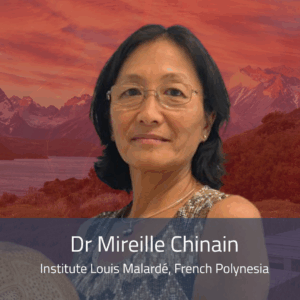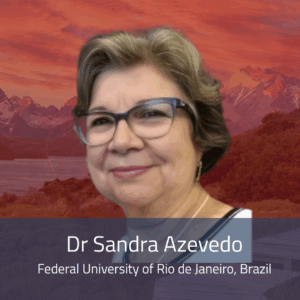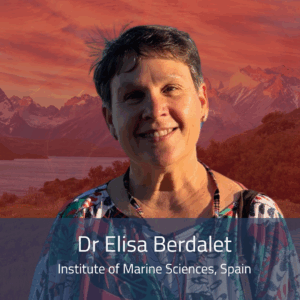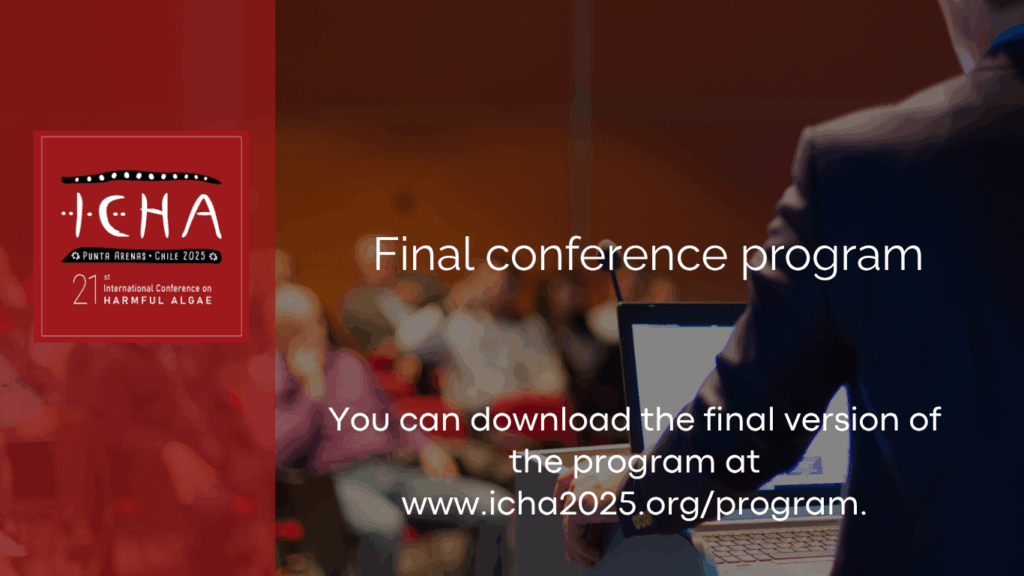Detailed Scientific Program
At the following link, you can download the updated scientific programme for the Conference*, which describes the schedules and distribution of each of the plenary talks, parallel sessions, poster sessions, workshops, ignite talks and activities that will be part of ICHA Conference.
(*) Last update October 20, 2025.
General Program
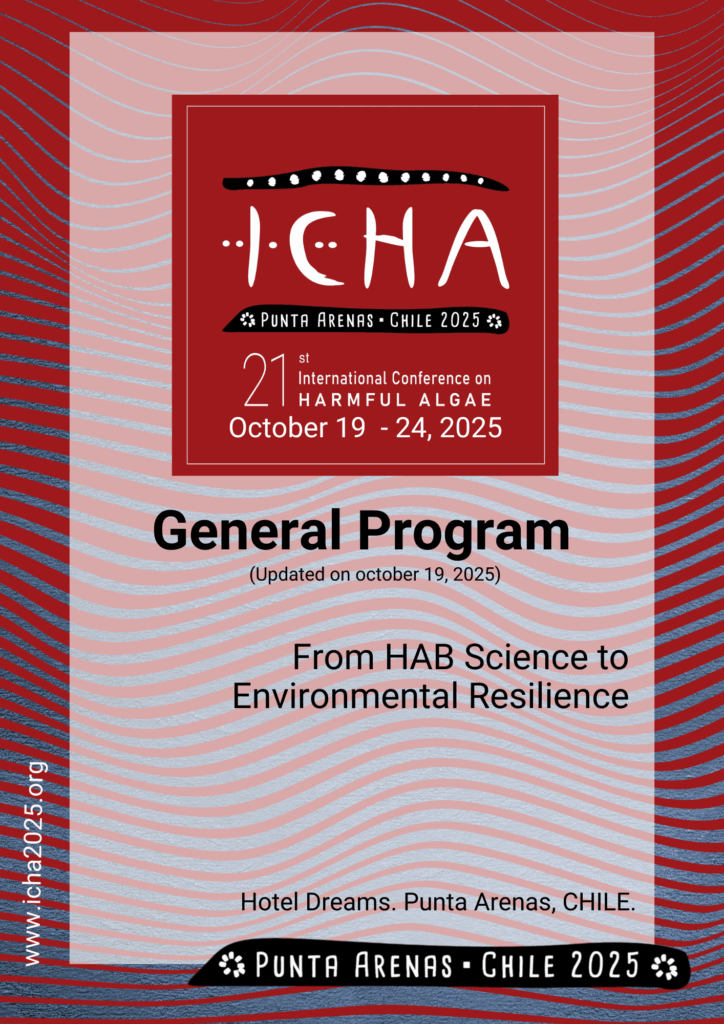
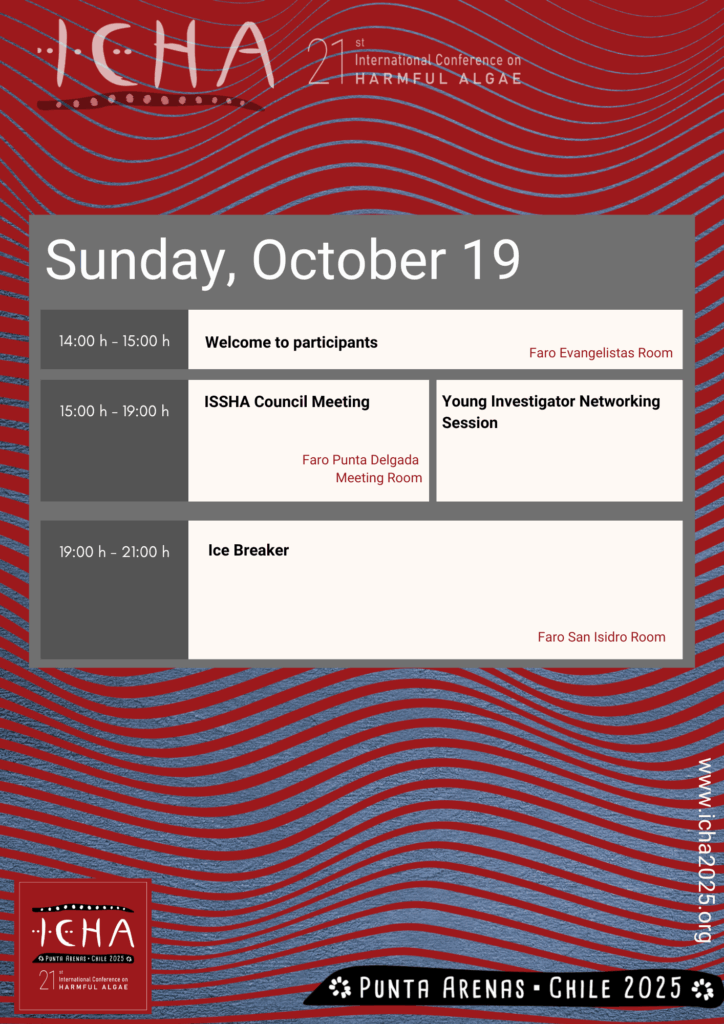
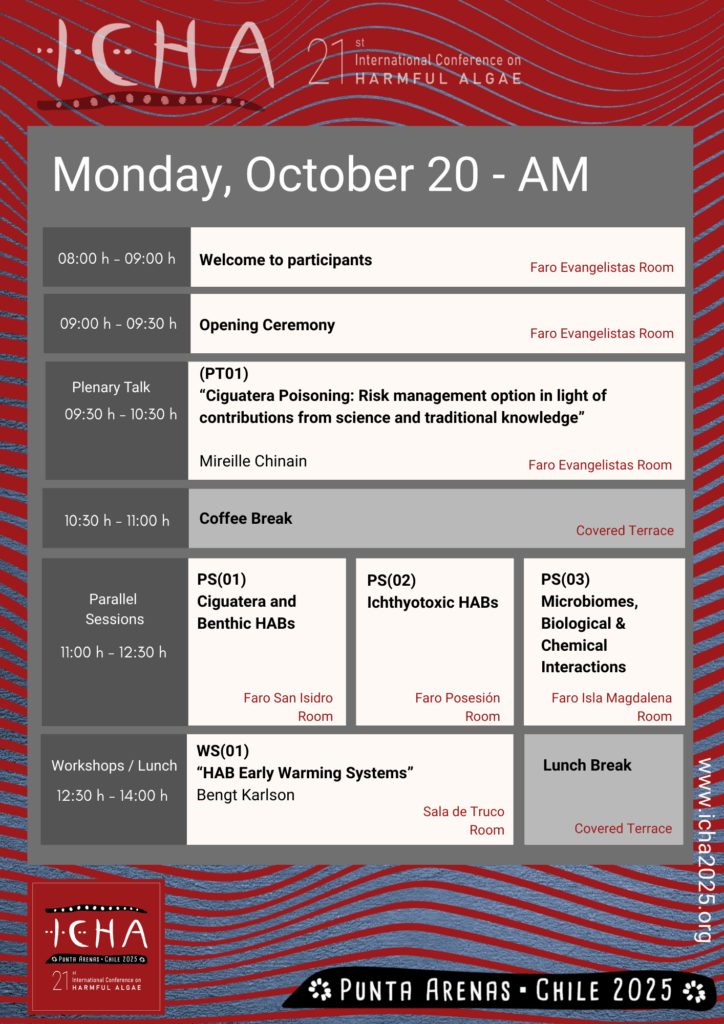
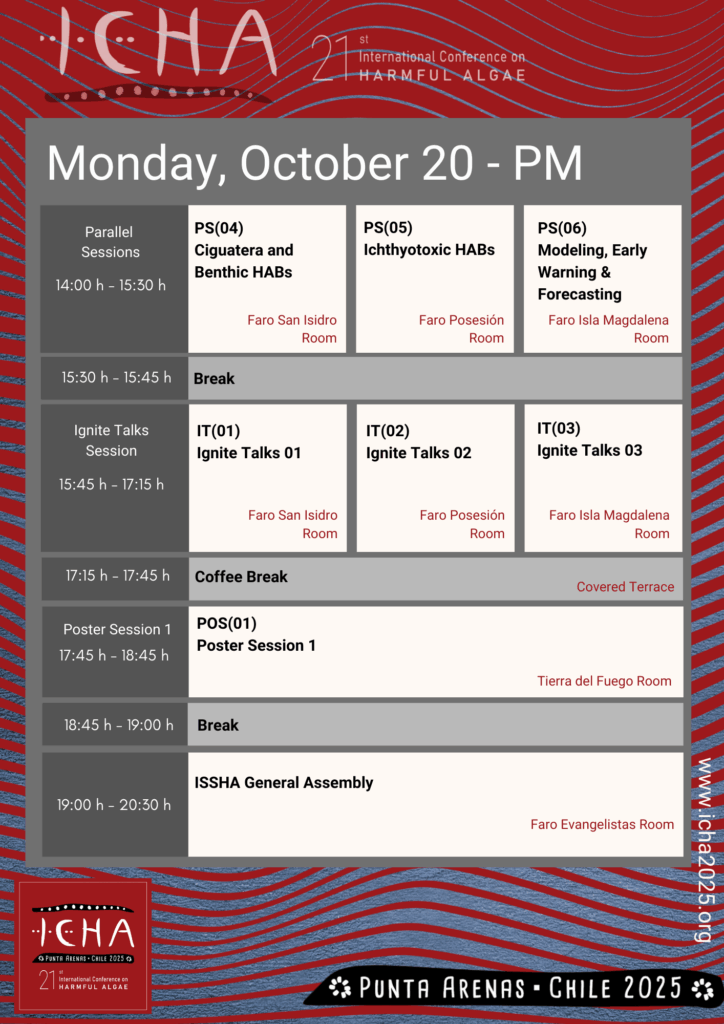
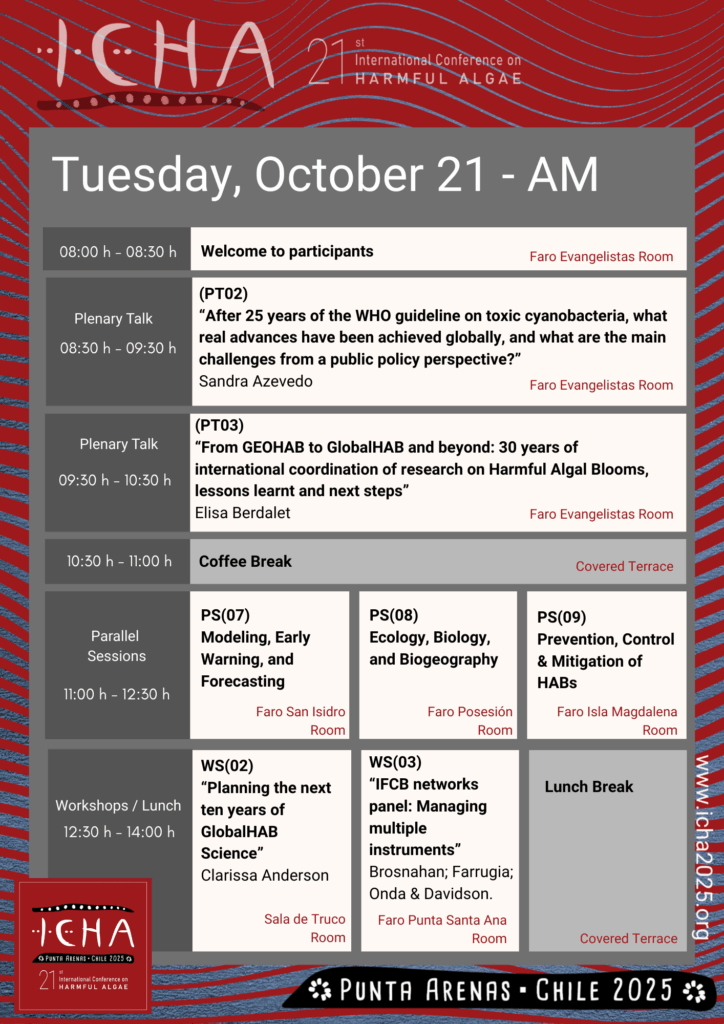
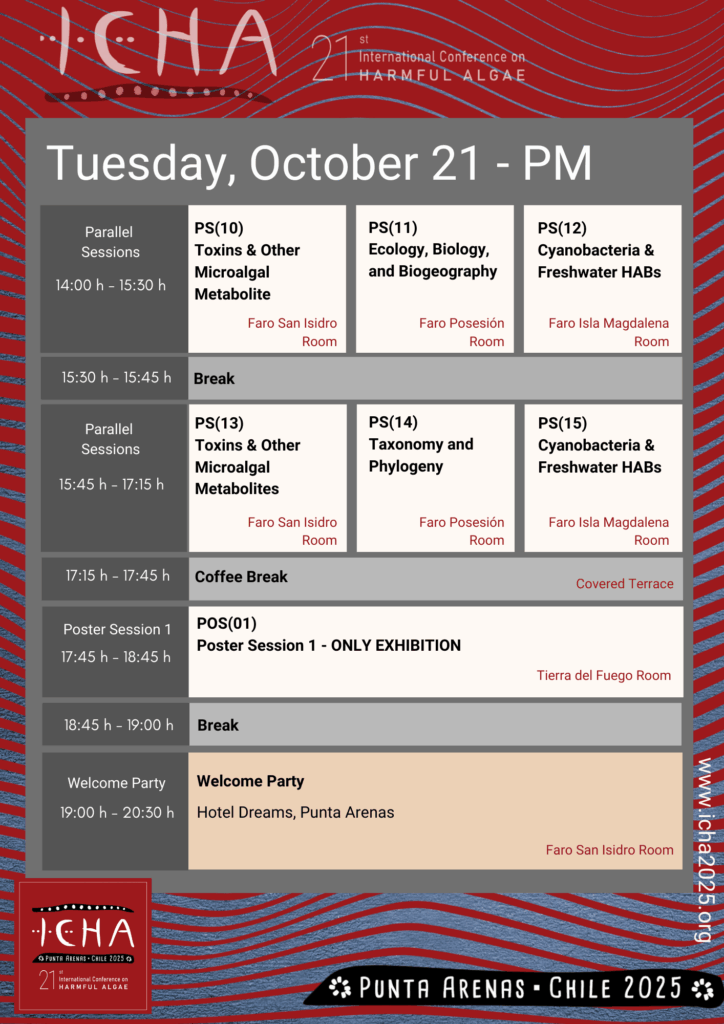
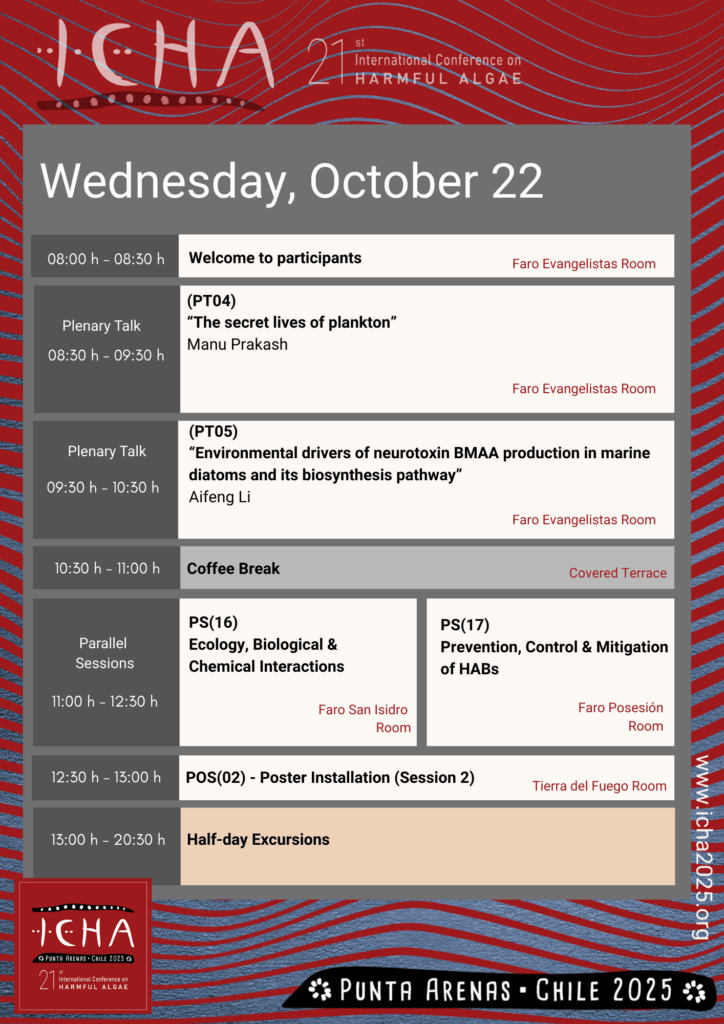
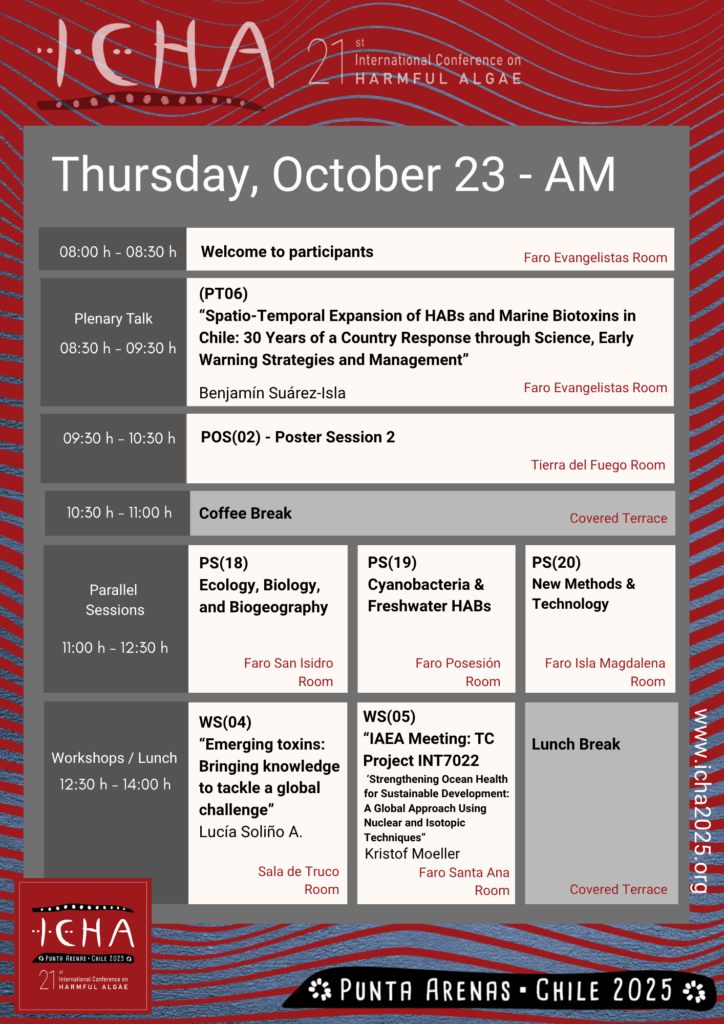
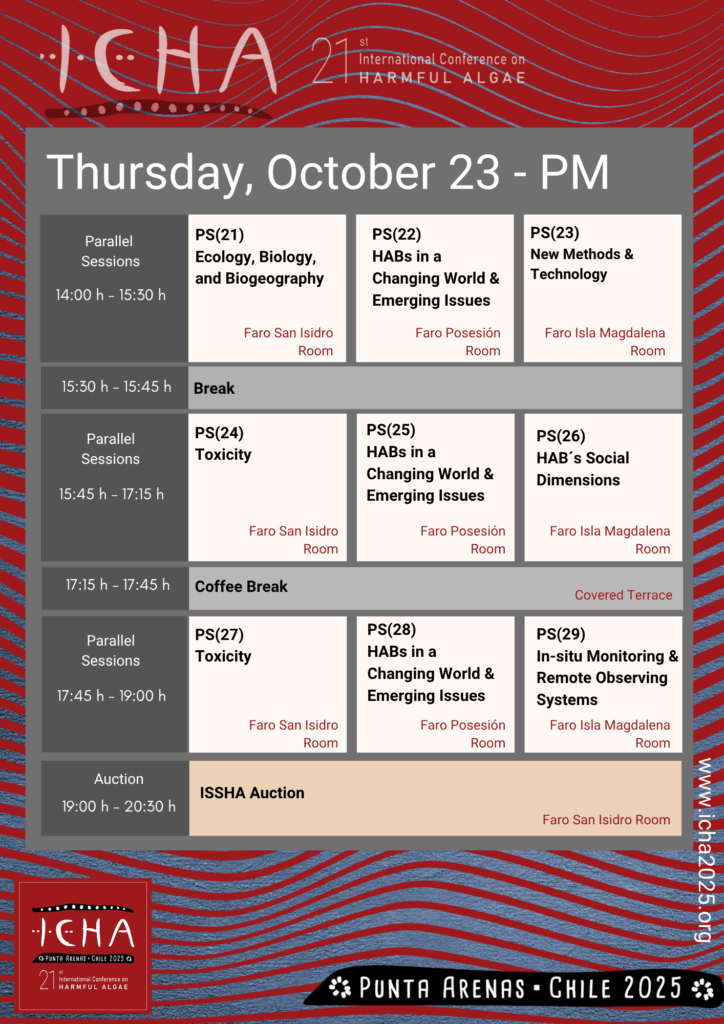
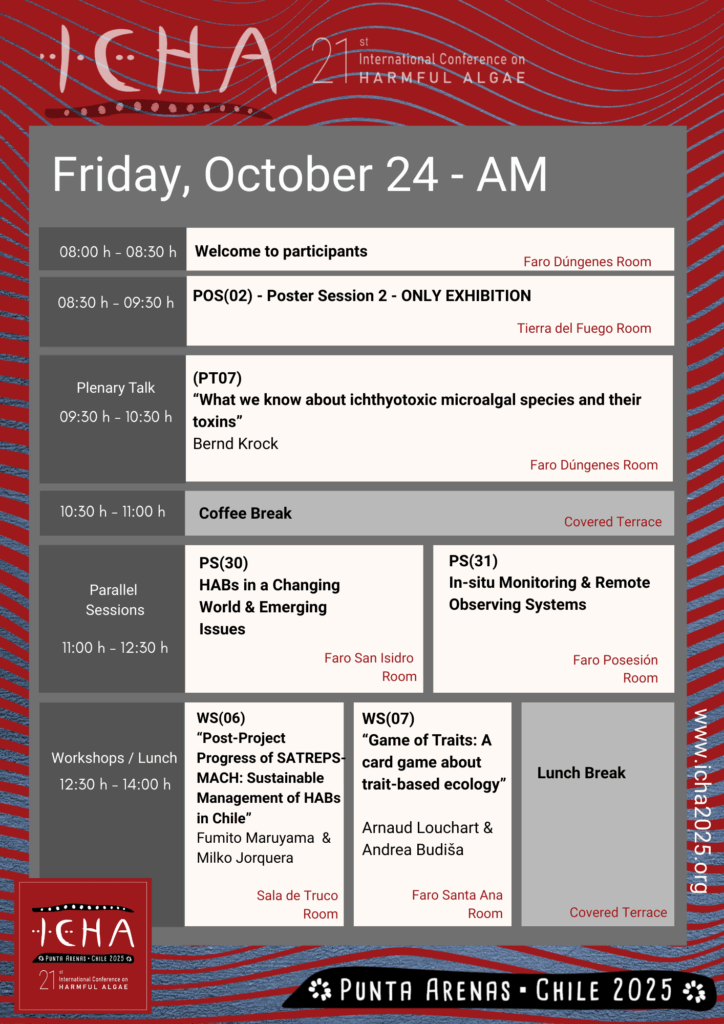
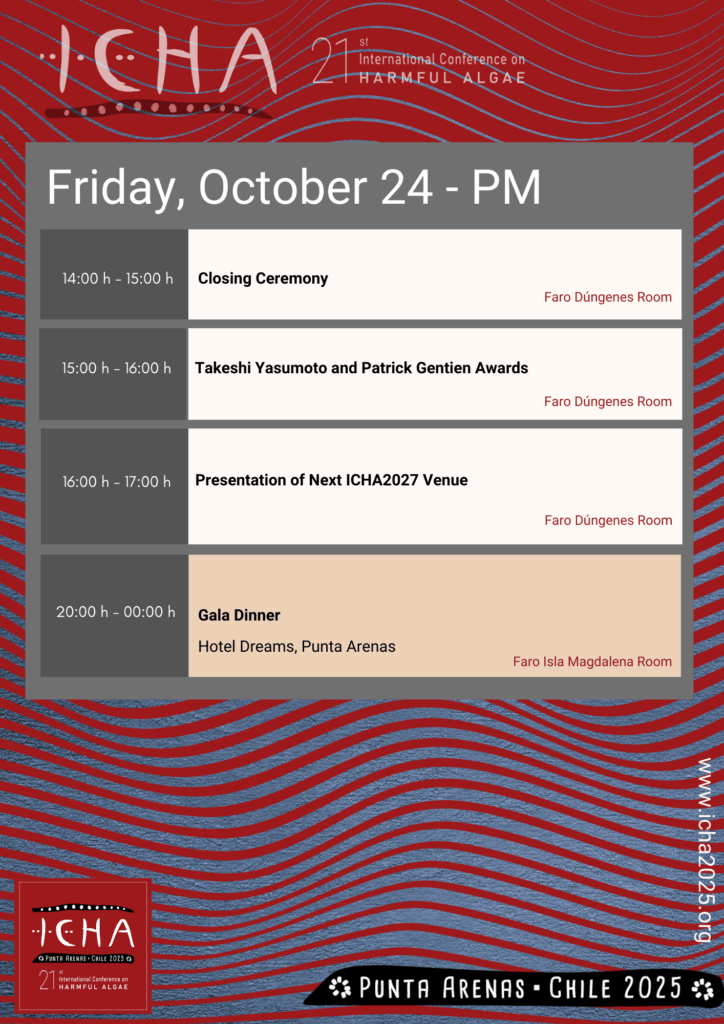
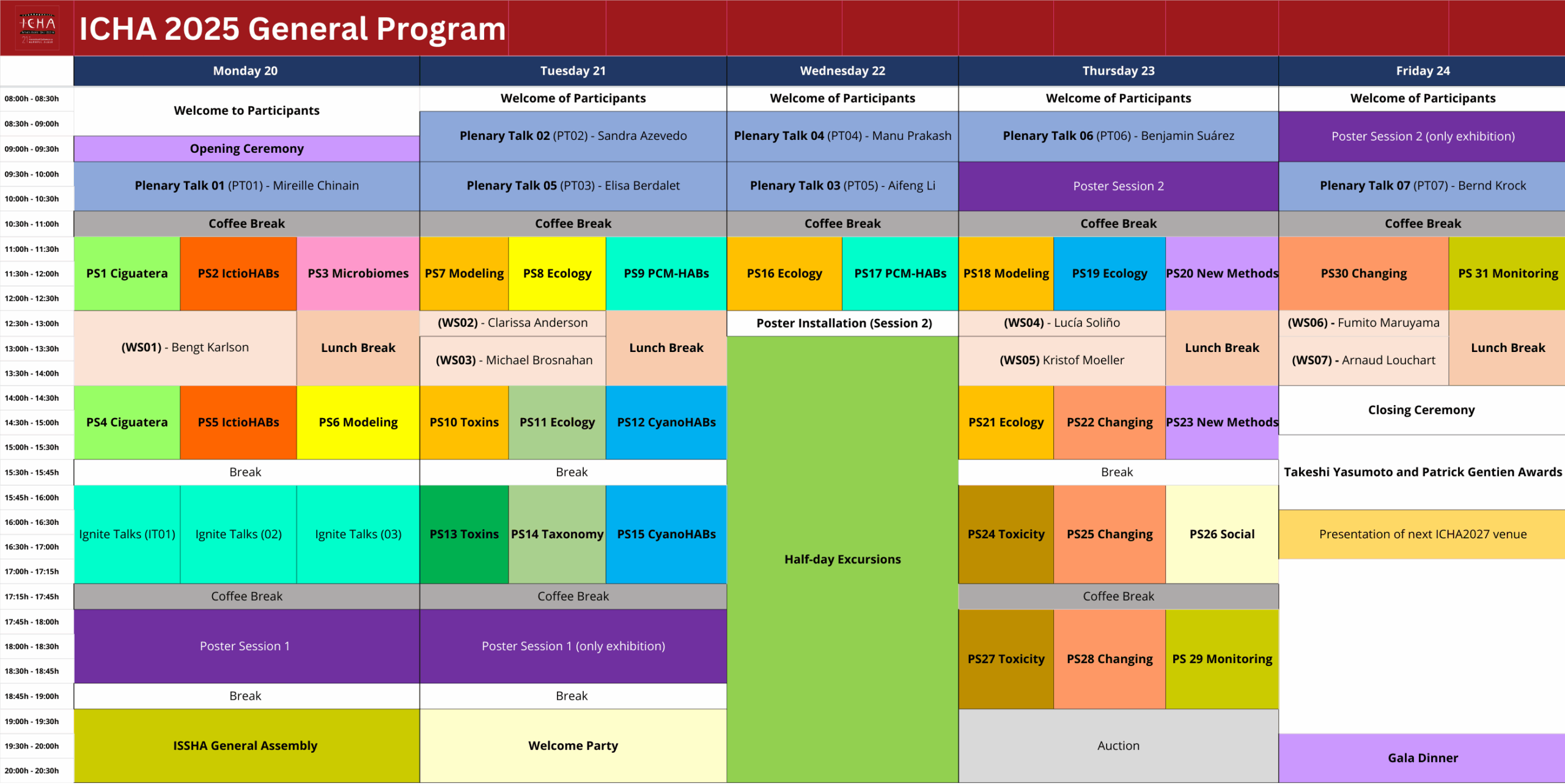
Plenary Talks
Click on the corresponding schedule to display each Plenary Talk information.
- 20 October 9:30 - 10:30
- 21 October 8:30 - 9:30
- 21 October 9:30 - 10:30
- 22 October 8:30 - 9:30
- 22 October 9:30 - 10:30
- 23 October 8:30 - 9:30
- 24 October 9:30 - 10:30
Plenary Talk (PT01)
“Ciguatera Poisoning: Risk management option in light of contributions from science and traditional knowledge”
Dr Mireille Chinain
Dr. Chinain serves as co-leader of the Intergovernmental Panel on Harmful Algal Blooms’ international strategy plan for ciguatera. She specializes in the study of ciguatera, a foodborne disease caused by consuming fish contaminated with this type of marine biotoxin. Dr. Chinain has conducted research into the ecology, biodiversity, and taxonomy of the dinoflagellate Gambierdiscus, which causes ciguatera, and has developed methods for toxin detection. She was the first recipient of the Yasumoto Lifetime Achievement Award in the Pacific region.
Plenary Talk (PT02)
“After 25 years of the WHO guideline on toxic cyanobacteria, what real advances have been achieved globally, and what are the main challenges from a public policy perspective?”
Dr Sandra Azevedo
Dr Sandra Azevedo, is one of the world’s leading researchers in the field of limnology and ecotoxicology of cyanobacteria that are toxic to human health. Her research focuses on phytoplankton ecology, cyanobacteria, cyanotoxins, bioaccumulation, and their impact on public health. In her lecture, Dr Azevedo will address the current state of research into cyanobacteria.
Plenary Talk (PT03)
“From GEOHAB to GlobalHAB and beyond: 30 years of international coordination of research on Harmful Algal Blooms, lessons learnt and next steps”
Dr Elisa Berdalet
PhD Senior Researcher at Institute of Marine Sciences (Spanish National Research Council). Her research aims to better understand the structure and dynamics of marine planktonic ecosystems and their responses to environmental or anthropogenic forcings. Expert in algal blooms, eutrophisation and ocean health.
Plenary Talk (PT04)
“The secret lives of plankton”
Dr Manu Prakash
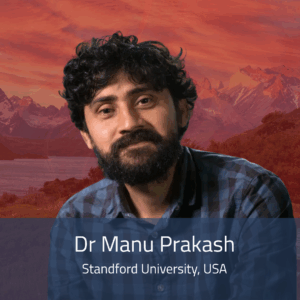 Dr Prakash, a scientist and professor of bioengineering at Stanford University, contributed to the design of the ‘Foldscope’, a low-cost optical microscope. This initiative is part of the ‘Frugal Science’ movement, which aims to make cheap and simple tools available for scientific use. One of the many global applications of the Foldscope is its use for monitoring toxic microalgae in remote locations.
Dr Prakash, a scientist and professor of bioengineering at Stanford University, contributed to the design of the ‘Foldscope’, a low-cost optical microscope. This initiative is part of the ‘Frugal Science’ movement, which aims to make cheap and simple tools available for scientific use. One of the many global applications of the Foldscope is its use for monitoring toxic microalgae in remote locations.
Plenary Talk (PT05)
“Environmental drivers of neurotoxin BMAA production in marine diatoms and its biosynthesis pathway”
Dr Aifeng Li
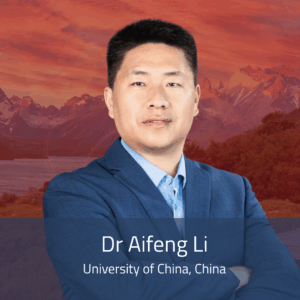
Dr. Aifeng Li’s research focuses on marine emerging contaminants and ecosystem health, including phycotoxins, microplastics, and perfluorinated compounds. His research includes the following areas:
Chemical ecology of aquatic toxins: Biosynthesis of phycotoxins: Monitoring methods for marine toxins; Metabolomics of phycotoxins in shellfish and Purification of emerging toxins.
Plenary Talk (PT06)
“Spatio-Temporal Expansion of HABs and Marine Biotoxins in Chile: 30 Years of a Country Response through Science, Early Warning Strategies and Management”
Dr Benjamín Suárez-Isla
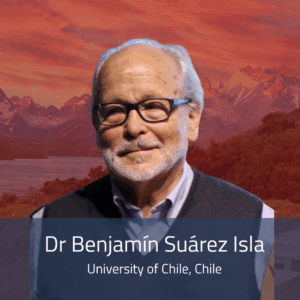 Dr Suárez has an outstanding track record in studying marine toxins and their impact on public health and food safety. His scientific work has enabled the development and validation of methods for the detection of marine biotoxins, and has contributed to the study of detoxifying contaminated molluscs through industrial processes and other strategies for mitigating the impacts of harmful algal blooms (HAB) in Chile.
Dr Suárez has an outstanding track record in studying marine toxins and their impact on public health and food safety. His scientific work has enabled the development and validation of methods for the detection of marine biotoxins, and has contributed to the study of detoxifying contaminated molluscs through industrial processes and other strategies for mitigating the impacts of harmful algal blooms (HAB) in Chile.
Plenary Talk (PT07)
“What we know about ichthyotoxic microalgal species and their toxins”
Dr Bernd Krock
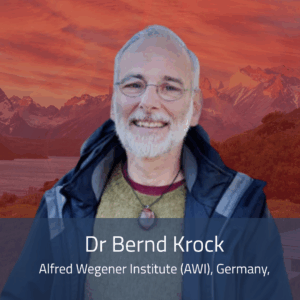 Dr Bernd Krock, a leading chemist at the Alfred Wegener Institute (AWI) in Bremerhaven, Germany, is an expert in phycotoxins and the analysis of trace organic compounds. He specializes in plant and algal secondary metabolites, as well as ecologically relevant signaling compounds. In recent years, he has worked on developing methods for detecting marine biotoxins by LC-MS/MS and discovery of new algal toxins as well as their producing organisms.
Dr Bernd Krock, a leading chemist at the Alfred Wegener Institute (AWI) in Bremerhaven, Germany, is an expert in phycotoxins and the analysis of trace organic compounds. He specializes in plant and algal secondary metabolites, as well as ecologically relevant signaling compounds. In recent years, he has worked on developing methods for detecting marine biotoxins by LC-MS/MS and discovery of new algal toxins as well as their producing organisms.
Workshops
Click on the corresponding schedule to display each Workshop information.
- 20 October 12:30 - 14:00
- 21 October 12:30 - 14:00
- 21 October 12:30 - 14:00
- 23 October 12:30 - 14:00
- 23 October 12:30 - 14:00
- 24 October 12:30 - 14:00
- 24 October 12:30 - 14:00
Workshop (WS01)
Sala de Truco Room
“HAB Early Warning Systems”.
Bengt Karlson.
Harmful algal blooms early warning systems can reduce effects of HABs. This is recognized by the UNESCO-IOC-FAO Intergovernmental Panel on Harmful Algal Blooms which includes the Task Team on the Early detection, warning and forecasting of HAB events. The workshop will include presentations by the Task Team members and workshop participants and also discussions. The organizers hope that participants will leave the workshop with new ideas and contacts.
Workshop (WS02)
Sala de Truco Room
“Planning the next ten years of GlobalHAB Science”.
Clarissa Anderson.
In 2017, GlobalHAB was designated a SCOR-IOC programme whose primary mission is to address the contemporary scientific and societal challenges of HABs by adopting a multidisciplinary approach through the evaluation and application of new advanced technologies, training and capacity building, and information and dissemination requirements. The programme has become synonymous with cutting-edge science co-designed for local, regional, national, and global decision-making on all topics pertaining to HABs. The widest international participation of the research community and stakeholders is essential to ensure the success of another ten years of the GlobalHAB programme. The influx of complementary global initiatives, such as the UN Decade of the Ocean, offers the GlobalHAB Scientific Steering Committee (SSC) an ideal landscape for shaping the next era of GlobalHAB activities. ICHA attendees are invited to join the SSC at this special town hall to provide feedback on new activities proposed in The Next Ten Years of GlobalHAB (2026-2035:) Science and Implementation Plan.
Workshop (WS03)
Faro Punta Santa Ana Room
“IFCB networks panel: Managing multiple instruments”.
Michael Brosnahan, Thomas Farrugia, Deo Onda, Keith Davidson.
In this session, panel members will discuss their experiences and challenges managing IFCB networks of multiple instruments. This “roundtable & lunch session” will be an opportunity to compare techniques for deployment practices, data handling and network management.
Workshop (WS04)
Sala de Truco Room
“Emerging toxins: Bringing knowledge to tackle a global challenge”.
Lucía Soliño Alonso.
In this session the main issues regarding the worldwide occurrence of emerging marine biotoxins will be discussed. This “roundtable & lunch session” is a unique an opportunity for strengthen research networks to address this global risk.
Workshop (WS05)
Faro Punta Santa Ana Room
“IAEA Meeting: TC Project INT7022 ‘Strengthening Ocean Health for Sustainable Development: A Global Approach Using Nuclear and Isotopic Techniques”.
Kristof Moeller.
Participants: Around 20 members of the interregional IAEA Technical Cooperation project INT7022. The official technical officer of this project is Carlos Alonso Hernandez.
Background: TC Project INT7022, called ‘Strengthening Ocean Health for Sustainable Development: A Global Approach Using Nuclear and Isotopic Techniques’, has the overall goal of conversation and sustainable usage of the oceans, seas, and marine resources for sustainable development. This project contained a workshop to discuss strategies to harmonize fieldwork, analytical protocols and data reporting for the sampling and identification of HABs and biotoxins in marine ecosystems using nuclear and complementary techniques. Many participants of this workshop will also attend the ICHA and we would be grateful to use this opportunity for an intermediary status report of INT7022 and to discuss further proceedings.
Workshop (WS06)
Sala de Truco Room
“Post-Project Progress of SATREPS-MACH: Sustainable Management of Harmful Algal Blooms in Chile”.
Fumito Maruyama, Milko A. Jorquera.
This session will present the post-project outcomes of the SATREPS-MACH initiative, focusing on sustainable strategies developed for managing harmful algal blooms (HABs) in Chile. Discussions will include advancements in HAB holobiomes, monitoring technologies, policy implementations, and community engagement achieved since the project’s conclusion. Additionally, recent research findings and their implications for future HAB management will be explored.
Workshop (WS07)
Faro Punta Santa Ana Room
“Game of Traits: A card game about trait-based ecology”
Arnaud Louchart, Andrea Budiša.
“Dive into a drop of water and experience the world of plankton! Equip yourself with traits. Fight microscopic monsters. Survive environmental challenges. Cooperate with others… but remember, there can only be one winner!”
This is a serious game developed by the Phytoplankton Research Group, led by D. Van de Waal, at the Netherlands Institute of Ecology, to teach the principles of trait-based ecology through the fascinating world of plankton. It is a deck-building game where players represent different algal groups. As you build your deck by acquiring new traits, you will enhance your resilience against a range of abiotic and biotic stressors. Throughout the game, you’ll face off against “microscopic monsters,” adapt to shifting environmental conditions, and navigate a landscape where collaboration and competition go hand in hand. While you may choose to cooperate with fellow players—or even sabotage their progress—only one can ultimately emerge victorious. This engaging and educational game offers a unique opportunity to explore the diversity and adaptability of plankton, making complex ecological concepts accessible and memorable through interactive play.
Parallel Sessions
Click on each room name to display the list of Parallel Sessions.
Monday 20 October
11:00 - 12:30
14:00 - 15:30
- Faro San Isidro
- Faro Posesión
- Faro Isla Magdalena
Parallel Sesion 1.
Ciguatera and Benthic HABs
11:00 (O-001) “Giant moray eel, a long living apex predator that poses a food safety risk in the Pacific”.
Sam Murray
11:15 – – –
11:30 (O-003) “Ciguatera poisoning in Australian waters: Investigating environmental, biological, and sociological drivers of risk”.
Greta Gaiani.
11:45 (O-004) “New Biogeographic records of Gambierdiscus spp. in subtropical Eastern Atlantic: From the tropical Gulf of Guinea to the temperate Azores Islands”.
Miguel Barbosa
12:00 (O-005) “A high ciguatoxin-producing Gambierdiscus clade (Gonyaulacales, Dinophyceae) as a major source of ciguatera in the Pacific”.
Christopher Bolch
12:15 (O-006) “Advancing knowledge on Caribbean ciguatoxin chemistry and development of critical reference materials”.
Elizabeth M. Mudge
Parallel Sesion 2.
Ichthyotoxic HABs
11:00 (O-007) “Chrysochromulina leadbeateri strikes again killing ≥2 mill fish in Northern Norway spring 2025”.
Ingunn A. Samdal.
11:15 (O-008) “The cytotoxicity of the haptophyte Chrysochromulina leadbeateri towards gill cell lines”.
Anita Solhaug.
11:30 (O-009) “Structure elucidation of leadbeaterin-1: The main fish-killing toxin from Chrysochromulina leadbeateri blooms in Northern Norwegian fjords”.
Thomas O. Larsen.
11:45 (O-010) “Sterolysin diversity during fish-killing Chrysochromulina leadbeateri blooms in Northern Norway”.
Christopher O. Miles
12:00 (O-011) “From morphology to toxicity: First characterization of the fishkilling Fibrocapsa japonica (Raphidophyceae) from Argentina”.
Delfina Aguiar Juárez.
12:15 (O-012) “Fish mortality event associated with harmful algal bloom in a Northern Tunisian Lagoon: A multifaceted crisis”.
Afef Fathalli.
Parallel Sesion 3.
Microbiomes, Biological & Chemical Interactions
11:00 (O-013) “Phenology of the toxic dinoflagellate Dinophysis along European coasts: long-term observation networks reveal different phenoregions and confirm the key role of prey availability”.
Victor Pochic.
11:15 (O-014) “The functional diversity of bacterial microbiota associated with toxigenic Prorocentrum species”.
Lorena María Durán Riveroll
11:30 (O-015) “A systematic quantitative review of the effects of PST toxins from Alexandrium on the copepod Acartia”.
Aldo Barreiro
11:45 (O-016) “Nitrogen acquisition from co-occurring phytoplankton by the dinoflagellate Alexandrium ostenfeldii“.
Elin Lindehoff.
12:00 (O-017) “How toxins and allelochemicals can shape phytoplankton communities, and example with Baltic Synechococcus”.
Zofia Konarzewska.
12:15 (O-018) “Exolymers and mucus in harmful algae: composition, properties and roles”.
Ian R. Jenkinson.
- Faro San Isidro
- Faro Posesión
- Faro Isla Magdalena
Parallel Sesion 4.
Ciguatera and Benthic HABs
14:00 (O-019) “The emerging threat of Ciguatera in Brazil”.
Silvia Nascimento.
14:15 (O-020) “Spatio-temporal dynamics of Gambierdiscus in the Balearic Islands”.
Jorge Diogène
14:30 (O-021) “Comparative transcriptomic analysis of polyketide synthase genes from Gambierdiscus polynesiensis and Gambierdiscus holmesii to identify candidate genes
potentially involved in ciguatoxin biosynthesis”.
Amna Ashfaq.
14:45 (O-022) “Sampling Ostreopsis cf. ovata along Campania coasts (Italy). An unprecedented combination of sample treatment and LC-MS to mitigate health risks associated to ovatoxins in seawater”.
Chiara Melchiorre .
15:00 (O-023) “A study on the temporal dynamics and environmental drivers of harmful marine microalgae in Mauritius”.
Manisha Curpen Mahadoo
15:15 (O-024) “SURVEY-TOX – A Pilot study on the monitoring of ciguatera poisoning and other emerging toxin risks for safer lagoon fisheries”.
Hélène Taiana Darius
Parallel Sesion 5.
Ichthyotoxic HABs
14:00 (O-025) “Understanding the fish-killing mechanisms of harmful algal blooms (HABs) from multifaceted perspectives: Insights from observations of multiple dinoflagellate species”.
Lixia Shang.
14:15 (O-026) “Turbulence tames toxicity: Controlling the growth and toxicity of the rust tide alga, Margalefidinium polykrikoides”.
Jiyeon Sung.
14:30 (O-027) “Heterosigma akashiwo blooms and Fish Kills in San Francisco Bay, CA, USA: Remote Sensing and Lab-Based Experiments to Understand the Ecology and Impacts”.
Raphael Kudela.
14:45 (O-028) “Large scale bloom of Karenia species in South Australia associated with extensive deaths of marine life”.
Shauna Murray
Parallel Sesion 6.
Modeling, Early Warning, and Forecasting
14:00 (O-029) “A decade of HAB reports: early warning of HABs and biotoxins for the aquaculture industry”.
Keith Davidson.
14:15 – – –
14:30 (O-031) “A three-dimensional mechanistic model for predicting Karenia brevis blooms on the West Florida Shelf”.
Ming Li.
14:45 (O-032) “Empirical Dynamic Modeling applied to Chilean fjords phytoplankton assemblages: an approach to identify causal relationships among harmful algal species and other microalgae species”.
Matias Volke.
15:00 – – –
15:15 (O-034) “A machine-learning based, shellfish biotoxin forecasting method: successes from Maine, USA and opportunities for other regions”.
Johnathan Evanilla.
Tuesday 21 October
11:00 - 12:30
14:00 - 15:30
15:45 - 17:00
- Faro San Isidro
- Faro Posesión
- Faro Isla Magdalena
Parallel Sesion 7.
Modeling, Early Warning, and Forecasting
11:00 (O-035) “A pilot program towards an Early Warning System for Harmful Algal Blooms in Bahía de La Paz, Gulf of California, Mexico”.
Christine Johanna Band-Schmidt.
11:15 (O-036) “Early warnings and predictions according to Alexandrium catenella abundances, mussels’ toxicity by paralytic toxins and hydrographical and meteorological conditions in Chilean fjords”.
Leonardo Guzmán.
11:30 (O-037) “Modeling anthropogenic and oceanographic drivers of domoic acid production in the Southern California Bight”.
Marco Sandoval-Belmar.
11:45 (O-038) “Influences of bottom temperature on Alexandrium catenella cyst dynamics in the Gulf of Maine”.
David Ralston.
12:00 (O-039) “Ocean warming reduces risk of paralytic shellfish toxin events from Alexandrium catenella in Tasmania, Australia”.
Lael Wakamatsu.
12:15 (O-040) “Bridging morphological traits and model attention for improved phytoplankton classification and forecasting”.
Paul Samuel Ignacio.
Parallel Sesion 8.
Ecology, Biology, and Biogeography.
11:00 (O-041) “Evolutionary insights into polyketide synthases in Amphidinium carterae”.
Armando Mendoza-Flores.
11:15 (O-042) “Intra- and inter-specific transcriptomic profiling of Alexandrium strains from Irish waters and the North Sea to identify novel molecular markers associated with toxins production”.
Francesca Cucchi.
11:30 (O-043) “Comparison of microscopy and metabarcoding for long-term monitoring of harmful algae taxa in the Western English Channel”.
Keelan Lawlor.
11:45 (O-044) “Phylogenetic diversity and yessotoxin variation of the marine dinoflagellate Lingulaulax polyedra from a western Sweden (Skagerrak) fjord system”.
Allan Cembella.
12:00 (O-045) “Domoic acid biosynthesis and genome expansion in Nitzschia navis-varingica“.
Steffaney Wood-Rocca.
12:15 (O-046) “Comparative genomics of harmful bloom-forming diatoms Pseudo-nitzschia”.
Zoltan Fuessy.
Parallel Sesion 9.
Prevention, Control and Mitigation (PCM-HABs)
11:00 (O-047) “A sustainable and innovative management system for toxic cyanobacteria blooming of surface waters with combined energy production, sustainable agriculture, and food safety (CYANOTECH)”.
Maria G. Antoniou.
11:15 (O-048) “Novel light-guided photocatalytic treatment for in situ control of harmful algal blooms”.
Diana S. Moura.
11:30 (O-049) “Towards scalable photocatalytic water treatment:Simplified preparation of g-C₃N₄ coated glass beads for microcystin-LR removal”.
Indira Menezes.
11:45 (O-050) “Development of Surfactant-based Foams for Targeted Control of Harmful Algal Blooms”.
Vincent Lovko.
12:00 (O-051) “Harmful Algal Bloom Mitigation of Dinoflagellate, Karenia brevis, Using Lake Guard® Oxy”.
Jessica R. Frost.
12:15 – – –
- Faro San Isidro
- Faro Posesión
- Faro Isla Magdalena
Parallel Sesion 10.
Toxins & Other Microalgal Metabolites
14:00 – – –
14:15 (O-054) “Isolation of polyketide toxins from free-living symbiotic Symbiodiniaceae”.
Emily Jolly.
14:30 (O-055) “Untargeted metabolomics of cytotoxic extracts of the benthic dinoflagellate Amphidinium eilatiense”.
María del Carmen Osorio-Ramírez.
14:45 (O-056) “Acquisition and evolution of the neurotoxin domoic acid biosynthesis genes in diatoms”.
Nansheng Chen.
15:00 (O-057) “Lipophilic cholinergic ligands from the marine cyanobacterium Oscillatoria cf. bonnemaisonii”.
Rómulo Aráoz.
15:15 (O-058) “Chemical stability of prymnesins”.
Tobias Mueller.
Parallel Sesion 11.
Ecology, Biology, and Biogeography
14:00 (O-059) “Blue holes and red tides: Underwater sink holes on the West Florida Shelf serve as a nutrient source for Karenia brevis”.
Patricia Glibert.
14:15 (O-060) “Dead or alive? How dinoflagellate HABs shift the coastal hypoxia paradigm”.
Christopher Gobler.
14:30 – – –
14:45 – – –
15:00 (O-063) “Microplastics and microalgae-phycotoxins: A synergistic toxicological risk in marine aquaculture environments”.
Jorge I. Mardones.
15:15 (O-064) “Realized Niche of Pseudo-nitzschia spp. in a coastal upwelling center off Central Chile”.
Catharina Alves-de-Souza.
Parallel Sesion 12.
Cyanobacteria & Freshwater HABs
14:00 (O-065) “Uncovering intraspecific trait plasticity in harmful cyanobacteria: A functional trait approach to understand bloom dynamics”.
Arnaud P. Louchart.
14:15 (O-066) “Microdiversity of Microcystis aeruginosa complex shows an incredible diversity of ecotypes”.
Gabriela Martínez de la Escalera.
14:30 (O-067) “Functional and genetic diversity of bloom-forming Cyanobacteria in the Laurentian Great Lakes”.
Carol Waldmann Rosenbaum.
14:45 (O-068) “Characterizing the freshwater cyanobacterium, Microcystis aeruginosa, using digital holography”.
Madison Bennett.
15:00 (O-069) “Silent stress: Iron limitation suppresses cyanobacterial growth but elevates toxin risk”.
Charlie Trick.
15:15 (O-070) “Salinity thresholds drive nonlinear cyanobacterial toxin responses in prairie lakes”.
Irena Creed.
- Faro San Isidro
- Faro Posesión
- Faro Isla Magdalena
Parallel Sesion 13.
Toxins & Other Microalgal Metabolites
15:45 (O-071) “Cyanotoxins in marine and freshwater cyanobacteria from LEGE-CC, Portugal”.
Flavio Luis de Oliveira.
16:00 (O-072) “Toxin profiles of Alexandrium ostenfeldii (Dinophyceae) strains isolated from the Beagle channel: Spirolide diversity”.
Luis Norambuena.
16:15 (O-073) “Prevalence and distribution of dissolved phycotoxins in seawater in the Yellow Sea and the Bohai Sea, China”.
Jiangbing Qiu.
16:30 – – –
16:45 (O-075) “10-year study of the occurrence and distribution of lipophilic marine toxins in shellfish from production areas in Chile”.
Fernanda Barrera.
Parallel Sesion 14.
Taxonomy and Phylogeny
15:45 (O-076) “Revisiting the taxonomy of Prymnesium parvum: Historical Challenges”.
Urban Tillmann.
16:00 (O-077) “The critical role of biological sample curation in advancing research on Eutreptiella (Euglenophyceae/Euglenozoa)”.
Sinuhé Hernández Márquez.
16:15 (O-078) “Intracellular ultrastructure of seven marine dinoflagellates of the Amphidomataceae, comparing azaspiracid-producing and non-toxigenic species”.
Koyo Kuwata.
16:30 (O-079) “Species diversity of amphidomatacean dinoflagellates in Japan based on morphological and molecular identification”.
Mitsunori Iwataki.
16:45 (O-080) “New toxins and harmful species: Updates from the IOC-taxonomic task team”.
Catarina Churro.
Parallel Sesion 15.
Cyanobacteria & Freshwater HABs
15:45 (O-081) “Cyanobacterial toxin profiling of 40 lakes in a temperate northern region”.
Malin Olofsson.
16:00 (O-082) “Predicting Cyanobacteria Blooms in U.S. Lakes Using National Scale Data”.
Kendall Ash.
16:15 (O-083) “Recovery and Characterization of Potentially Toxin-Producing Cyanobacteria from a Century-Old Reservoir”.
Katelyn McKindles.
16:30 (O-084) “Global change impacts on cyanobacterial bloom toxicity: Scaling from traits to threats”.
Dedmer B. Van de Waal.
16:45 (O-085) “A freestream in situ digital holographic imaging system for monitoring cyanobacterial blooms in freshwater lakes”.
Aditya R. Nayak.
17:00 (O-086) “Cyanotoxins diversity and their biotechnological potential”.
Vitor Vasconcelos.
Wesnesday 22 October
11:00 - 12:30
- Faro San Isidro
- Faro Posesión
Parallel Sesion 16.
Ecology, Biology, and Biogeography
11:00 (O-087) “The role of G protein-coupled receptors in red tide dinoflagellate bioluminescence”.
Libin Ye.
11:15 (O-088) “Rapid sexual reproduction in Dinophysis acuminata revealed through temporal partitioning of cellular processes”.
Serena Sung-Clarke.
11:30 – – –
11:45 (O-090) “Distribution dynamics of vitamin B12, Pseudonitzschia sp. and domoic acid in the Northwest Passage”.
Elisabeth Rosselli.
12:00 – – –
12:15 (O-092) “A year long in situ survey of HAB species and their respective metabolic activities in the Northern Adriatic Sea”.
Daniela Maric Pfannkuchen.
Parallel Sesion 17.
Prevention, Control, and Mitigation (PCM-HABs)
11:00 (O-093) “Controlling harmful algal blooms (HABs) in marine waters: current status and future prospects”.
Vera Trainer.
11:15 (O-094) “In situ Impacts of modified clay on Karenia brevis cell concentrations, water quality, and microbial communities”.
John Kristoffer Andres.
11:30 (O-095) “Using modified clay to mitigate fjord HAB taxa: Laboratory results using species from Chile, Scotland, and Norway”.
Anita Flores Leñero.
11:45 (O-096) “Synchronous removal of the potent marine algal toxins in mitigating harmful algal blooms using modified clay”.
Lianbao Chi.
12:00 (O-097) “Development of HAB mitigation using modified clays in China”.
Zhiming Yu.
12:15 (O-098) “Enhancing carbon sequestration through flocculation of harmful algal blooms”.
Xiuxian Song.
Thurdsday 23 October
11:00 - 12:30
14:00 - 15:30
- Faro San Isidro
- Faro Posesión
- Faro Isla Magdalena
Parallel Sesion 18.
Ecology, Biology, and Biogeography
11:00 (O-099) “Are we in an unprecedented era of HAB-driven marine mammal mortality events in coastal California?”
Clarissa Anderson.
11:15 (O-100) “Investigation of phytoplankton blooms at a reference station in Algoa Bay, South Africa”.
Brishan Kalyan.
11:30 (O-101) “Characterization of HAB-associated Microplankton around Karachi coast and the Indus River Estuary (IRE)”.
Sher Khan.
11:45 (O-102) “Distribution patterns of phytoplanktonic assemblages associated with harmful dinoflagellates in the Chilean fjord system based on a 16-year time series”.
Gemita Pizarro Nova.
12:00 (O-103) “Pollution dynamics and sustainable management of toxic elements associated with harmful algal blooms in coastal Bangladesh”.
M. Safiur Rahman.
12:15 (O-104) “Changing microalgal communities: approaches for holistic monitoring of harmful algal blooms”.
Kirsty Smith.
Parallel Sesion 19.
Cyanobacteria & Freshwater HABs
11:00 (O-105) “Transforming cyanobacteria biomass into sustainable biofertiliser: A review”.
Jabulani Gumbo.
11:15 (O-106) “Cyanobacterial community responses to nutrient reduction and warming: Insights from 45 years of monitoring”.
Jordan Facey.
11:30 (O-107) “Three-dimensional analysis of Microcystis colonies: what controls size during blooms in North American lakes?”
Ronojoy Hem.
11:45 (O-108) “The fate of toxic cyanobacteria in soil and impacts on food safety: Application of drinking water treatment residuals in CyanoHAB-impacted regions in US”.
Yuehan Ai.
12:00 (O-109) “Is it time to integrate molecular cyanobacterial assays into water monitoring programs?”
Mark Van Asten.
12:15 (O-110) “Latitudinal expansion of toxin cyanobacterial blooms in continental aquatic ecosystems of Southern Chile: Evidence from recent records”.
Claudia Pérez.
Parallel Sesion 20.
New Methods & Technology
11:00 (O-111) “Non-target analysis by liquid chromatography‒high-resolution mass spectrometry: application in algal and cyanobacterial toxin measurement”.
Pearse McCarron.
11:15 (O-112) “Mining discarded molecular data for HAB gold”.
Martin Pfannkuchen.
11:30 – – –
11:45 (O-114) “Assessment of novel molecular tools for the early detection of Alexandrium minutum in Italian coastal waters (Mediterranean Sea)”.
Giorgia Zoffoli.
12:00 (O-115) “A Rapid molecular assay for discrimination of potentially toxic Pseudo-nitzschia spp. using recombinase polymerase amplification and nanopore Sequencing”.
Robert Hatfield
12:15 (O-116) “Ammonium concentrations limiting HAB species growth cannot be accurately determined using the traditional indolphenol blue colorimetric method – The fluorometric ortho-phthaldialdehyde method is recommended instead”.
R. Wayne Litaker.
- Faro San Isidro
- Faro Posesión
- Faro Isla Magdalena
Parallel Sesion 21.
Ecology, Biology, and Biogeography
14:00 (O-117) “Recurrent co-occurrence of Pseudo-nitzschia australis and Eucampia zodiacus in Baja California coastal waters: Evidence of emerging harmful phytoplankton assemblages”.
Mary Carmen Ruiz de la Torre.
14:15 (O-118) “Gymnodinium catenatum in the shellfish production areas of the northeastern Atlantic”.
Yolanda Pazos.
14:30 (O-119) “Long term salinity adaptation in Nodularia spumigena supports northwards expansion potential in the Baltic Sea”
Carolin Peter.
14:45 (O-120) “First record of a Trichodesmium sp. bloom in waters of the Argentine Continental Shelf and its possible relationship with the outbreak of Alexandrium spp”.
María Guillermina Ruiz.
15:00 (O-121) “Intensification and spread of inshore Alexandrium catenella blooms in Cape Cod, Massachusetts”.
Michael Brosnahan.
15:15 (O-122) “Spatiotemporal dynamics of the 2018 Alexandrium catenella bloom in Aysén, Southern Chile”.
David Cassis.
Parallel Sesion 22.
HABs in a Changing World & Emerging Issues
14:00 (O-123) “Dynamics of the massive cyst beds of the toxic dinoflagellate Alexandrium catenella in the rapidly warming Pacific Arctic”.
Donald Anderson.
14:15 (O-124) “Summertime heat waves in the lower Chesapeake Bay and their effects on blooms of the harmful algae Margalefidinium polykrikoides”.
Margaret Mulholland.
14:30 (O-125) “Combined effects of warming and nitrogen availability on harmful algal blooms in the Dutch coastal North Sea”.
Andrea Budiša.
14:45 – – –
15:00 (O-127) “The role of harmful dinoflagellate blooms in controlling the temporal and spatial dynamics of hypoxia and acidification in Northwest Atlantic estuaries”.
Ryan Wallace.
15:15 (O-128) “The impact of environmental change on long-term trends in harmful algal blooms in a southeastern Australian estuary”.
Dora Vig.
Parallel Sesion 23.
New Methods & Technology
14:00 (O-129) “Non-Targeted Mass Spectrometry-Based Metabolomics for Comprehensive Annotation of Cyanobacterial Metabolites in Greek Lakes”.
Sevasti-Kiriaki Zervou.
14:15 – – –
14:30 (O-131) “Metabolomic insights in the basal metabolism of Amphidinium and Coolia, species associated with biofilms”.
Nadia Valeria Herrera Herrera.
14:45 (O-132) “Strengthening marine toxin surveillance: Implementing isotopic techniques on ciguatoxin quantitation in the Philippines”.
Ma. Llorina Mestizo.
15:00 (O-133) “Optimization of the extraction protocol for Pacific ciguatoxins from marine products prior to analysis using the neuroblastoma cell-based assay”.
Mélanie Roué.
15:15 (O-134) “An Electrochemical immunosensor for tetrodotoxin and saxitoxin detection: A step towards integrated seafood toxin monitoring”.
Jaume Reverté.
15:45 - 17:00
17:45 - 19:00
- Faro San Isidro
- Faro Posesión
- Faro Isla Magdalena
Parallel Sesion 24.
Toxicity
15:45 – – –
16:00 (O-136) “Reversal of nondepolarizing nicotinic acetylcholine receptor block induced by 6- or 7-membered cyclic imine toxins using 3,4-diaminopyridine in isolated mouse diaphragm preparations”.
Jordi Molgo.
16:15 (O-137) “Disclosing the functions of nuclear receptors NR1J1 in bivalves and toxin metabolism. New insights from in vitro and in vivo studies”.
Alexandre Campos.
16:30 (O-138) “Cytotoxic and membrane-disruptive properties of Prymnesium parvum extracts”.
Elisabeth Varga.
16:45 (O-139) “Combined toxicity of co-occurring harmful algal bloom species: Cellular and molecular effects on gametes of the Pacific oyster (Crassostrea gigas)”.
Rima Beesoo.
17:00 (O-140) “Toxicity of Karenia species on Greenshell mussel reproduction: insights into the potential bloom impact on aquaculture in New Zealand”.
Mathilde Madre.
Parallel Sesion 25.
HABs in a Changing World & Emerging Issues
15:45 (O-141) “Effects of temperature and light on the growth and domoic acid production of the diatom Pseudo-nitzschia multiseries from the California Current System”.
William P. Cochlan.
16:00 (O-142) “Evaluating 37 years of harmful algal blooms in Southern Chile”.
Alejandro Clément.
16:15 (O-143) “The emerging risks of toxic benthic dinoflagellates in the Magellan Subantarctic ecoregion under climate change scenarios: Is migration to the south an option?”
Máximo Frangópulos.
16:30 (O-144) “Increasing presence of harmful algal bloom toxins in Arctic food webs linked to ocean warming”.
Kathi Lefebvre.
16:45 – – –
17:00 (O-146) “The IOC harmful algal information system – The value of the global long-time series database HAEDAT”.
Dave Clarke.
Parallel Sesion 26.
HABs and Social Dimensions
15:45 (O-147) “HABs and human affairs: Lessons from our interactions with bacterial and viral pathogens”.
Gustaaf Hallegraeff.
16:00 (O-148) “Harmful algal bloom perceptions among school students in Southern Chile: insights into a preventive education and communication approach”.
Pamela Carbonell.
16:15 (O-149) “Investigating the association between harmful algal blooms and asthma incidence in coastal Madagascar: A multi-year remote sensing analysis”.
Kira Hülsdünker.
16:30 (O-150) “A preliminary study on the method of economic loss evaluation of marine ecosystems caused by HABs: Based on the impact of hypoxic environment on ecosystems”.
Yingze Xu.
16:45 (O-151) “Assessment of national policies on harmful algal blooms in the Latin American and Caribbean (LAC): Challenges for policy makers towards 2030 agenda for sustainable development”.
Leon Vergara.
17:00 (O-152) “What does an average recreator know about harmful algal blooms? Communication takeaways from a Utah, USA public perception survey”.
Hannah Bonner.
- Faro San Isidro
- Faro Posesión
- Faro Isla Magdalena
Parallel Sesion 27.
Toxicity
17:45 (O-153) “Histological damage and mortality rates in juveniles of the oyster Magallana gigas due to exposure to cells and cell lysates of Alexandrium spp”.
Ismavy de la Caridad Castillo Quintana.
18:00 (O-154) “Pathological fingerprint of harmful algal blooms in farmed salmon from southern Chile”.
Diego Caro.
18:15 (O-155) “Effects of the antibiotic azithromycin on Daphnia-Cyanobacteria interaction: revealing the impacts of environmentally relevant concentrations”.
Michael Celano.
18:30 (O-156) “Combined biotoxin exposure in the smalltooth sawfish, Pristis pectinata: Clues to an unusual mortality event throughout the Florida Keys, United States”.
Sarah Dietrick.
18:45 (O-157) “Saxitoxin linked to deaths of Northern fur seals in the Southeast Bering Sea”.
Chelsea Campbell.
Parallel Sesion 28.
HABs in a Changing World & Emerging Issues
17:45 (O-158) “Extreme flood event triggers a massive toxic bloom of Dinophysis cf. acuminata in Southern Brazil”.
Luiz Mafra Jr.
18:00 (O-159) “Turbulence, temperature and termination: Another role for climate change in Karenia brevis blooms”.
Cynthia Heil.
18:15 – – –
18:30 (O-161) “Global occurrence of mixed blooms of harmful algae: Toxicity and impacts on marine resources”.
Leila Basti.
18:45 (O-162) “Baseline dataset of harmful algal blooms (2024-2025) for Saudi Arabian Red Sea coast”.
Afrah Al Othman.
Parallel Sesion 29.
In Situ Monitoring and Remote Observing Systems
17:45 (O-163) “Aqusens: A field-deployable holographic imaging system for HAB cell detection”.
Holly Bowers.
18:00 (O-164) “Real-Time Monitoring of Harmful Algae: SAMS Validation Against Optical Microscopy and FlowCam Technologies”.
Nicole Correa.
18:15 (O-165) “Developing an AI-assisted model to differentiate Pseudo-nitzschia morphotypes from warm tropical waters using IFCB-generated images”.
Gian Carlo Gaetos.
18:30 (O-166) “Developing an Imaging FlowCytobot monitoring program to detect harmful algal blooms in Alaska”.
Thomas Farrugia.
18:45 (O-167) “From pixels to patterns: Automated in situ imaging reveals diel vertical migration among phytoplankton”.
Karin Garefelt.
Friday 24 October
14:00 - 15:30
- Faro San Isidro
- Faro Posesión
Parallel Sesion 30.
HABs in a Changing World & Emerging Issues
11:00 (O-168) “Aerosol particles in the Western Philippines increase the growth of Alexandrium minutum in batch cultures”.
Richard Redil.
11:15 (O-169) “Harmful algal blooms in South-Central Chile: Impacts, challenges, and research perspectives”.
Oscar Espinoza-González.
11:30 – – –
11:45 (O-171) “Mussels under stress: Okadaic acid accumulation from toxin-coated microplastics and its molecular and histological consequences”.
Estela Pires.
12:00 (O-172) “HABs watch: Developing and implementing an integrated in situ observation network for HABs monitoring under disaster risk reduction (DRR) framework”.
Deo Florence L. Onda.
Parallel Sesion 31.
In Situ Monitoring and Remote Observing Systems
11:00 (O-173) “Improved strategies for tracking Karenia brevis across bloom stages”.
Katherine Hubbard.
11:15 (O-174) “An Early Warning System for detecting Harmful Algal Blooms in the English Channel”.
Gavin Tilstone.
11:30 (O-175) “Development of an early detection, warning, and prediction system for cyanobacteria in the Baltic Sea”.
Bengt Karlson.
11:45 (O-176) “Monitoring of potentially harmful microalgae in the coastal area of the Magdalena Department, Colombian Caribbean coast”.
Julian Franco Angulo.
12:00 (O-177) “Harmful algal bloom detection in small, inland water bodies using machine learning and satellite imagery”.
Emily Dorne.
12:15 – – –
Ignite Talks
Click on each room name to display the list of Ignite Talks.
Monday 20 October, 15:45 - 17:00
- Faro San Isidro
- Faro Posesión
- Faro Isla Magdalena
Ignite Talks Sesion 1.
15:45 (P-007) “Dead or alive? Assessing viability and recovery of rounded Karenia brevis cells induced by putrescine and temperature stress”.
Devin Burris.
15:50 (P-009) “Ecosystem service trade-offs driven by eutrophication and socioeconomic pressures in reservoir cascade”.
Sheila Cardoso.
15:55 (P-012) “Toxicity and bioluminescence in Pyrodinium bahamense blooms: The luminous lies of cheats”.
Kathleen Cusick
16:00 (P-013) “Mixotrophic Strategies and Habitat Influences on Dinoflagellate Blooms in the Coastal Baltic Sea”.
Johanna Exner.
16:05 (P-016) “Linking organic matter sources to diarrhetic shellfish toxin accumulation in coastal mussels during a harmful algal bloom”.
João Paulo Felizardo.
16:10 (P-017) “Succession of Ostreopsis blooms: Community structure of zoosporic parasites associated with dinoflagellates on the Basque coast”.
Alan Denis Fernández Valero.
16:15 (P-027) “Biogeography and toxin diversity of Alexandrium along Chilean Pacific Coast”.
Javier Paredes-Mella.
16:20 (P-030) “Assessment of potentially toxigenic benthic dinoflagellates in two Cuban coral reefs: abundance patterns across sites and substrates”.
Gabriel Livan Rojas Abrahantes.
16:25 (P-040) “Complex viral and bacterial interactions revealed for the harmful bloom forming dinoflagellate Karenia brevis“.
Joaquín Martínez Martínez
16:30 – – –
16:35 (P-045) “First Observation of Ostreopsis fattorussoi Accoroni, Romagnoli & Totti in Benthic Mucilage in the Eastern Mediterranean: A New Risk for Coastal Ecosystems?”
Yelda Aktan.
16:40 (P-055) “The influence of abiotic and biotic factors on the succession of Ostreopsis spp. along the Basque coast (South-East Bay of Biscay)”.
Yago Laurenns-Balparda.
16:45 – – –
16:50 (P-071) “Monitoring microcystins-producing Microcystis in the Tobari Bay, Mexico”.
Pamela Helué Morales Sandoval.
16:55 (P-073) “Adaptive role of extracellular vesicles in phosphoruslimited Microcystis aeruginosa“.
Cezar Nascimento.
Ignite Talks Sesion 2.
15:45 (P-075) “Didymosphenia geminata blooms in freshwater ecosystems from central to austral Chile (~ 35.4°–54.6° S): Latitudinal distribution and environmental correlates.
David Andrés Opazo Vega.
15:50 (P-079) “First report of potentially microcystin-producing Microcystis in the Dominican Republic”.
Alfaniris Vargas Fernandez.
15:55 (P-081) “Application of non-thermal plasma technologies as an eco-friendly strategy for the treatment of cyanobacteria and health-relevant cyanometabolites”.
Luciana Tartaglione.
16:00 (P-086) “Why are some blooms of the haptophyte Prymnesium parvum harmful but others not?”
Jan Köhler.
16:05 (P-087) “Autecology and impacts of Heterosigma akashiwo in low-inflow estuaries: From research to management”.
Daniel Lemley.
16:10 (P-089) “FlowCam: Semi automatic tool for phytoplankton analysis”.
Natalia Pravatta.
16:15 (P-091) “Flexible feeding in changing fjords: Trophic plasticity of bivalves facing harmful algal blooms and glacial influences in Southern Chile”.
Claudia Andrade Diaz.
16:20 (P-094) “Initial assessments of nitrogen-induced ‘tipping points’ for harmful algal bloom development in New York/Connecticut (USA) estuaries”.
Dianne Greenfield.
16:25 (P-095) “Multi-stressor dynamics: Effects of marine heatwave stress and harmful algal blooms on juvenile mussel (Perna canaliculus) survival and physiology.
Hannah Greenhough.
16:30 (P-098) “CyanoHABs transfer along a freshwater-marine continuum and potential associated risks: Case of the Jacarepaguá Lagoon System (RJ, Brazil)”.
Mauro Cesar Palmeira Vila.
16:35 (P-099) “Implication of nitrogen and sulfur limitation on resources allocation and dimethylsulfoniopropionate (DMSP) production in toxic dinoflagellates”.
Laura Pezzolesi.
16:40 (P-103) “How will rising ocean temperatures affect growth rates and toxigenicity of Protoceratium reticulatum, a yessotoxin-producing dinoflagellate.
Megan Schulz.
16:45 (P-108) “Occurrence of phycotoxins and toxic microalgae in the Sea of Marmara, Türkiye”.
Fuat Dursun.
16:50 (P-109) “Culture optimisation of Vulcanodinium rugosum for biomass production and purification of portimine”.
Philipp Hess.
16:55 (P-115) “Toxic dinoflagellate Ostreopsis cf. ovata recorded for the first time in the area of Boka Kotorska Bay (South Adriatic Sea)”.
Dragana Drakulovic.
Ignite Talks Sesion 3.
15:45 (P-117) “Mitochondria as environmental sensors: Unravelling the link between Prymnesium parvum biotoxins and Mitochondrial Network”.
Zsuzsanna Neer.
15:50 (P-126) “Advancing HABs monitoring in Ireland: an in-house qPCR-based toolkit for detecting Pseudo-nitzschia species”.
Nicolè Caputo.
15:55 (P-127) “A loop-mediated isothermal amplification method (LAMP) for detecting toxic Microcystis”.
Carolina Croci.
16:00 (P-130) “Survey of cyanotoxins from various isolates from around the United States”.
Stuart Oehrle.
16:05 (P-135) “Phytoplankton integrated multiscale monitoring in the English Channel and North Sea: Automated/high throughput approaches for characterizing changes in phytoplankton assemblies and harmful algal blooms”.
Luis Felipe Artigas.
16:10 (P-136) “Next generation sequencing applied to toxic algae monitoring in Adriatic Sea in Italy, the experience of Emilia Romagna and Marche Regions”.
Barbara Bertasi.
16:15 (P-140) “Development of a satellite-based algorithm for green Noctiluca discrimination in the upper Gulf of Thailand using in-situ bio-optical observations”.
Jutarak Luang-on.
16:20 (P-144) Adaptive governance for sustainable fisheries: Insights from the scallop fishery of the Eastern English Channel (France) faced with HAB and emerging challenges.
Sarra Chenouf.
16:25 (P-150) “Local perceptions of the HABs’ impacts in Chilean Patagonia”.
Rodolfo Sapiains.
16:30 – – –
16:35 (P-164) “Specification for field control of HABs in different scenarios by using modified clay”.
Yongquan Yuan.
16:40 – – –
16:45 (P-167) “BloomPredictor: Integrating AI and ecological data for harmful algal bloom risk prediction”.
Alvaro Jorquera.
16:50 (P-168) “Algal bloom prevention and management through end-user driven forecasting and seasonal planning apps”.
Lisa Krimsky.
16:55 (P-169) “Forecasting cyanobacteria cell counts for inland water: A hybrid approach”.
Duy Nguyen.
Poster Presentations
Click on each Topic name to display the list of Poster presentations.
Poster Session 1
Monday 20 October, 17:45 - 18:45
Tuesday 21 October, 17:45 - 17:00 (only exhibition)
- Taxonomy and Phylogeny
- Ecology, Biology, and Biogeography
- Microbiomes, Biological & Chemical Interactions
- Ciguatera and Benthic HABs
- Cyanobacteria & Freshwater HABs
| Code | Title | Presenter | Authors |
| P-001 | Phylogeny and ultrastructure of a novel marine Gymnodinium species (Gymnodiniales, Dinophyceae) isolated from Hokkaido, Japan. | Kuwata Koyo | Koyo Kuwata, Mitsunori Iwataki |
| P-002 | Identification of Pseudo-nitzschia species using rRNA (Nanopore technology) in Southern Chile. | Latorre-Melín Laura | Laura Latorre-Melín, Robert Hatfield, Nicole Correa, Stephanie Sáez, Carlos Flores, Carla Palma, Álvaro Jorquera, Alejandro Clément |
| P-003 | Catalog of Planktonic Dinoflagellates from the Guatemalan Pacific: New Records and Paralytic Shellfish Poisoning Events. | Paz Karla | Karla Paz, Yuri Okolodkov, Fernando Cobo |
| P-004 | Harmful algae: 17 years of research in Buenos Aires coastal waters (Argentina). | Sunesen Inés | Inés Sunesen, Jonás Tardivo Kubis, Delfina Aguiar Juárez, Eugenia Sar |
| Code | Title | Presenter | Authors |
| P-005 | Trophic transfer of paralytic shellfish toxin: impact on biochemical composition and reproduction of the carnivorous snail Chorus giganteus. | Andrade Paola | Paola Andrade, Ángel Urzúa, Jorge Navarro |
| P-006 | Diversity of benthic dinoflagellates in the Magellan Subantarctic ecoregion: morphological characterization in intertidal habitats with special emphasis on toxic species. | Bahamonde Mihovilovich Francisco | Francisco Bahamonde Mihovilovich, Máximo Frangopulos, Luiz L. Mafra Jr., Luciano F. Fernandes, Juan Pablo Rodríguez, Fabio Méndez, Johanna Marambio, Andrés Mansilla |
| P-007 | Dead or Alive? Assessing Viability and Recovery of Rounded Karenia brevis Cells Induced by Putrescine and Temperature Stress. | Burris Devin | Devin Burris, Michael Parsons, Vince Lovko, Cindy Heil |
| P-008 | Alexandrium catenella in Chilean fjords: Characteristics of its genome and effect of temperature on core genes (sxtA4 and sxtG) of the synthesis cluster. | Carbonell Pamela | Pamela Carbonell, Shauna Murray, Pablo Salgado, Luis Norambuena, Leonardo Guzmán, Gemita Pizarro, Marcela Astorga, Gonzalo Fuenzalida |
| P-009 | Ecosystem Service Trade-Offs Driven by Eutrophication and Socioeconomic Pressures in Reservoir Cascade. | Cardoso Sheila | Sheila Cardoso, Paulo Alves de Lima Ferreira, Diego de Souza Sardinha, Rubens C.L. Figueira, Marcelo Pompêo, Eduardo Vicente, Viviane Moschini-Carlos |
| P-010 | Morphological landmarks in Prorocentrum koreanum showed consistency in varying salinity conditions as revealed by Imaging Flow CytoBot coupled with machine learning. | Chan Gerard Paul | Gerard Paul Chan, Kristian Boado, Joshua Allen Canlas, Samantha Mari Peniano, James Suello, Jay Robert Ramos, Paul Samuel Ignacio, Bryan Miguel Tul-ao, Deo Florence Onda |
| P-011 | First report of the marine dinoflagellate Tripos furca bloom in a warm temperate bay (South Africa). | Cotiyane-Pondo Phumlile | Phumlile Cotiyane-Pondo, Mfundo Bizani, Shaun H.P Deyzel, Thomas G. Bornman |
| P-012 | Toxicity and Bioluminescence in Pyrodinium bahamense blooms: The Luminous Lies of Cheats. | Cusick Kathleen | Kathleen Cusick, Sydney Hall, Nicole Brown, Gregory L. Boyer, Edith Widder |
| P-013 | Mixotrophic Strategies and Habitat Influences on Dinoflagellate Blooms in the Coastal Baltic Sea. | Exner Johanna | Johanna Exner, Hanna Farnelid, Catherine Legrand, Elin Lindehoff |
| P-014 | Bloom of Heterocapsa circularisquama in Mar del Plata Harbor, Southwest Atlantic Ocean: Description of Two Strains with Lytic Activity Against Other Plankton Components. | Fabro Elena | Elena Fabro, Gastón Almandoz, Martina Mascioni, Belén Matera, Bernd Krock, Urban Tillmann |
| P-016 | Linking Organic Matter Sources to Diarrhetic Shellfish Toxin Accumulation in Coastal Mussels During a Harmful Algal Bloom. | Felizardo João Paulo | João Paulo Felizardo, Alana Guimarães, Ricardo Coutinho, Luiz Mafra Jr, Silvia Nascimento, Roberto Dos Anjos |
| P-017 | Succession of Ostreopsis blooms: Community structure of zoosporic parasites associated wit dinoflagellates on the Basque coast. | Fernández Valero Alan Denis | Alan Denis Fernández Valero, Yago Laurenns Balparda, Pablo Aramendi, Jone Bilbao, Laia Moreno, Marina Salido, Estibalitz Txurruka, Sergio Seoane |
| P-018 | Southernmost detection of Pectenotoxins-2 in Antarctic waters using SPATT. | Frangopulos Rivera Máximo Jorge | Máximo Jorge Frangopulos Rivera, Gemita Pizarro, Claudia Zamora, Vanessa Monge, Luis Norambuena, Erling Johnson, Francisco Bahamonde, Pablo Guerrero. |
| P-019 | Spatial distribution of harmful algal bloom in Nuevo Gulf and their likely negative effects on the environment during spring 2022. | Gracia Villalobos Leilén | Leilén Gracia Villalobos, Guillermina Ruiz, Gabriela Williams |
| P-020 | Genetic diversity and vertical distribution of amphidomatacean dinoflagellates off the coast of Hokkaido, Japan, detected by metabarcoding and quantitative PCR analyses. | Kuwata Koyo | Koyo Kuwata, Kazuma Nakano, Taketoshi Kodama, Kazutaka Takahashi, Mitsunori Iwataki |
| P-021 | Harmful Algal Blooms in Latin America and Caribbean. | Martínez Goicoechea Ana | Ana Martínez Goicoechea, Karla Paz |
| P-022 | Amphidomataceae Bloom in the Río De La Plata Continental Shelf, Southwest Atlantic. | Martínez Goicoechea Ana | Ana Martínez Goicoechea, Ricardo Silva, Elena Fabro |
| P-023 | Seasonal and Spatial Distribution of Three Dominant Diatom Genera: Chaetoceros, Skeletonema, and Pseudo‑nitzschia in Singapore’s Waters. | Mon Aye Aye | Aye Aye Mon |
| P-024 | Comparison of growth and toxin production of Vulcanodinium rugosum strains grown under two different conditions: batch and agitated cultures. | Moreira González Angel Ramón | Angel Ramón Moreira González, Pedro Reis Costa, Catarina Churro, Lisbet Díaz Asencio, Donaida Consorcia Chamero Lago |
| P-025 | A spatio-temporal analysis of the occurrence of harmful algal blooms in Chile: a review between 1956 and 2021. | Oliva Doris | Doris Oliva, Camila Barria, Pablo Conejeros, Pablo Herrera, Benjamín Suárez-Isla, Leonardo Guzmán, L. René Durán |
| P-026 | Experimental exposure of harmful microalgae Alexandrium catenella, Prorocentrum lima and Heterosigma akashiwo on the Chilean mussel Mytilus chilensis. | Oliva Doris | Doris Oliva, Camila Barria, Catalina Lizama, Piera Vásquez-Calderón, Pablo Herrera, Pablo Conejeros, Karin Lohrmann, L. René Durán |
| P-027 | Biogeography and Toxin Diversity of Alexandrium along Chilean Pacific Coast. | Paredes-Mella Javier | Javier Paredes-Mella, Oscar Espinoza-González, Ana Flores-Leñero, Luis Norambuena-Subiabre, Jorge Mardones, Julia Cáceres-Chamizo, Bianca Zubicueta-Olivares, Cristina Hernández, Gonzalo Fuenzalida, Leonardo Guzmán |
| P-029 | Phytoplankton assemblages associated to a bloom of Pseudo-nitzschia pseudodelicatissima complex and Phaeocystis spp. in subantarctic fjords of southern Chile during the austral spring 2021. | Pizarro Nova Gemita | Gemita Pizarro Nova, Francisco Bahamonde, César Alarcón, Carolina Toro, Pablo Salgado, Luis Norambuena, Erling Johnson, Andrés Mansilla, José Luis Iriarte, Máximo Frangopulos |
| P-030 | Assessment of potentially toxigenic benthic dinoflagellates in two Cuban coral reefs: abundance patterns across sites and substrates. | Rojas Abrahantes Gabriel Livan | Gabriel Livan Rojas Abrahantes, Lisbet Díaz Asencio , Victor Alfonso Cervantes Urieta, Lorena María Durán Riveroll |
| P-031 | Spatial distribution of harmful algal bloom in Nuevo Gulf and its effects on a coastal ecosystem with anthropogenic impact. | Leilén Luciana Gracia Villalobos | Leilén Luciana Gracia Villalobos, María Guillermina Ruiz, Nora Gladys Montoya, Gabriela Noemí Williams |
| P-032 | Harmful microalgae (motile cells and cysts) and marine toxins on the Chilean southern continental shelf between the Chacao Channel (41°S) and Cape Horn (56.2°S). | Salgado Pablo | Pablo Salgado, Gemita Pizarro, César Alarcón, Roberto Raimapo, Carolina Toro, Marta Godoy, Claudia Zamora, Luis Norambuena, Gonzalo Fuenzalida, Carolina Zuñiga, Pamela Carbonell, Leonardo Guzmán |
| P-033 | Spatial and temporal variability of dinoflagellate assemblages in relation to water quality parameters in Singapore waters. | Yim Shereen S. P. | Shereen S. P. Yim |
| Code | Title | Presenter | Authors |
| P-034 | Zooplankton community responses to harmful algal blooms induced by non-indigenous and indigenous dinoflagellates Lingulodinium polyedra and Tripos furca. | Bizani Mfundo | Mfundo Bizani, Phumlile Cotiyane-Pondo, Thomas G. Bornman, Shaun H.P. Deyzel |
| P-035 | Identification of potential luxR homologs related to the Quorum-Sensing system in Microcystis aeruginosa. | Blanco Ortiz Ana Paula | Ana Paula Blanco Ortiz |
| P-036 | Genomic signatures of HAB phytoplankton growth-promoting microbiome bacteria. | Bolch Christopher | Christopher Bolch, Andrew Bridle, David Green, Frederick De Boever, Shauna Murray, Shady Amin, Gustaaf Hallegraeff, Shikder S Islam |
| P-037 | Do toxic dinoflagellates host distinctive bacteria in their phycospheres? | Deng Yunyan | Yunyan Deng |
| P-038 | Exploring the 16S rRNA– and 18S rRNA–based microbial communities in coastal seawater during harmful algal blooms in Chilean coasts. | Jorquera Milko | Jingming Hu, Yanrong Zhou, Joaquín Rilling, Marco Campos, Tay Ruiz-Gil, Cristobal González, Javiera Manquian, Karen Vergara, Mariela Gonzalez, Andrés Ávila, Leonardo Guzmán, Oscar Espinoza-González, Gonzalo Fuenzalida, Pamela Carbonell, Gonzalo Gajardo, Carlos Riquelme, Henry Camerón, Shoko Ueki, Satoshi Nagai, Fumito Maruyama, So Fujiyoshi, Kyoko Yarimizu, Ishara Uhanie Perera, Jacquelinne Acuña, Qian Zhang, Milko Jorquera |
| P-039 | Functional shifts in aquatic plant-associated bacterial communities during Microcystis suppression. | Lee Hayoung | Hayoung Lee, Seonah Jeong, Chi-Yong Ahn |
| P-040 | Complex viral and bacterial interactions revealed for the harmful bloom forming dinoflagellate Karenia brevis. | Martínez Martínez Joaquín | Joaquín Martínez Martínez, Anne E. Booker, Cong Fei, Shady Amin, Cynthia Heil, Patricia Glibert |
| P-041 | Do extracellular vesicles has a role in the allelopathic interaction of saxitoxin-producing Raphidiopsis raciborskii with other phytoplankton? | Nascimento Cezar | Cezar Nascimento, Mauro Vilar, Paulo Bisch, Ana Beatriz Pacheco |
| P-042 | Assessment of the allelopathic potential of Ulva sp. and Macrocystis pyrifera against the toxic microalga Alexandrium catenella. | Polanco Yugreisy | Yugreisy Polanco, Alejandra Llanos-Rivera, Allisson Astuya-Villalón |
| P-043 | HALOBISE. Platform to understand the effects of the harmful algal bloom holobiont in a changing environment to predict their impact on aquatic ecosystem services. | Romalde Jesús | Susana Cristóbal, Jean Armengaud, Aldo Barreiro, Jesús Romalde, Yolanda Pazos |
| Code | Title | Presenter | Authors |
| P-045 | First Observation of Ostreopsis fattorussoi Accoroni, Romagnoli & Totti in Benthic Mucilage in the Eastern Mediterranean: A New Risk for Coastal Ecosystems? | Aktan Yelda | Yelda Aktan |
| P-046 | Hotspots and Hideouts: comparative study of the annual cycle of Ostreopsis spp blooms in NW Mediterranean and in El Hierro (Canary islands). | Berdalet Elisa | Elisa Berdalet, Rosa Trobajo, Emilio Soler-Onís, David Mann, Ted T. Packard, Magda Vila, May Gómez, Josep Lloret, Ico Martínez, Alba Garriga, Sofía I. Homedes, Sofía Huelbes, Adrian Kryk |
| P-047 | Ostreopsis spp and benthic diatom interactions in contrasting sites: NW Mediterranean and El Hierro (Canary Islands). | Berdalet Elisa | Rosa Trobajo, David G. Mann, Emilio Soler-Onis, Adrian Kryk, Alba Garriga, Sofía I. Homedes, Ico Martínez, Sofía Huelbes, May Gómez, Ted. T. Packard, Magda Vila, Elisa Berdalet |
| P-048 | Taxonomic and Metabolomic Diversity of Benthic Cyanobacterial Mats on Caribbean Coral Reefs. | Berthold David | David Berthold, Anastasia Hiskia, H. Dail Laughinghouse IV |
| P-049 | Working together to address a global challenge: Towards a harmonized standard operating procedure for detecting ciguatoxins using the neuroblastoma cell-based assay. | Ceinos Rosa María | Rosa María Ceinos, Begoña Ben-Gigirey, Pablo Sosa, Jorge Diogène, Sandra Leonardo, Christopher Loeffler, Sophie Trotereau, Fernando Real, María José Ramos Sosa, Andrés Sanchez Henao, Jean Turquet, Mirjam Klijnstra, H. Taiana Darius, Lucía Soliño Alonso |
| P-050 | Presence, diversity, and toxicological characterization of benthic dinoflagellates Gambierdiscus spp. in the Mediterranean Sea. | Cervera-Piñana Joan Josep | Joan Josep Cervera-Piñana, Lourdes Barreiro-Crespo, Andrés Sánchez-Henao, María García-Altares, Sandra Gimeno-Monforte1, Jaume Reverté, Mònica Campàs, Francisco Rodríguez, Maria García-Portela, Rosa Trobajo, David G. Mann, Cintia Flores, Maria Rey, Karl Andree, Jorge Diogène, Maria Rambla-Alegre |
| P-051 | Toxicological profile of Gambierdiscus strains from different species and origins. | Cervera-Piñana Joan Josep | Maria Rambla-Alegre, Joan Josep Cervera-Piñana, Sandra Gimeno-Monforte, Francisco Rodríguez, Isabel Ramilio, Andrés Sánchez-Henao, Jorge Diogène, Begoña Ben-Gigirey |
| P-052 | Diversity, toxicity and toxin profile of Gambierdiscus in Cuba. | Díaz Asencio Lisbet | Lisbet Díaz Asencio, Joan Josep Cervera-Piñana, María Rey, Sandra Leonardo, Gabriel L. Rojas-Abrahantes, Donaida Chamero-Lago, Karl B. Andree, María Rambla-Alegre, María García-Altares, Jorge Diogène, Mònica Campàs |
| P-053 | Integrated Monitoring of Toxic Benthic Dinoflagellates on the Spanish Levantine Coast. | Diogène Fadini Jorge | Olga Carnicer, María García Altares, Chiara Incani, María Rambla Alegre, Joan Josep Cervera Piñana, Bartolomé Morote Sánchez, Javier Gilabert Cervera, Jose Manuel Moreno Angosto, Jorge Diogène Fadini, Margarita Fernández Tejedor |
| P-054 | PACIFIC CIGUAWATCH: A regional initiative to improve Ciguatera surveillance and mitigation in the South Pacific | GATTI HOWELL Clémence | Clémence GATTI HOWELL, Hélène Taiana DARIUS, Mireille CHINAIN |
| P-055 | The influence of abiotic and biotic factors on the succession of Ostreopsis spp. along the Basque coast (South-East Bay of Biscay). | Laurenns-Balparda Yago | Yago Laurenns-Balparda, Pablo Aramendi, Jone Bilbao, Alan Denis Fernández-Valero, Laia Moreno-Martínez, Marina Salido, Estibalitz Txurruka, Sergio Seoane |
| P-056 | Identifying the cause of acute mortality in naïve Mytilus sp. from Great Britain, experimentally exposed to the potentially future invasive microalgal species, Ostreopsis cf. ovata. | Lewis Adam | Adam Lewis, Ben Maskrey, Ryan Alexander, Andrew Turner, Matthew Green, John Bignell, Antonella Penna, Carmela Dell’Aversano, Valentina Miele, Luciana Tartaglione, Michela Varra, Silvia Casabianca, Samuela Capellacci, Chiara Melchiorre, Linda Percy, Jane Lewis |
| P-057 | Changes in benthic dinoflagellates abundance and species composition associated with organic pollution in an oceanic island of the Atlantic Ocean. | Nascimento Silvia | Geovanna Borsato, Alexandra Grigoriyan, Raquel Neves, Joel DePaula, Nilva Brandini, Silvia Nascimento |
| P-058 | New molecular and morphological data of Ostreopsis species from Brazil. | Nascimento Silvia | Rodrigo Silvia, Fabiano Salgueiro, Silvia Nascimento |
| P-059 | Benthic dinoflagellates from the oceanic Trindade island, South Atlantic Ocean. | Nascimento Silvia | Giovanna Argollo, Geovanna Borsato, Joel De Paula, Carlos Ferreira, Silvia Nascimento |
| P-061 | Distinct Ciguatoxin Profiles in Fish Involved in Poisoning Events from the Indian Ocean. | Reverté Jaume | Joan Josep Cervera-Piñana, Jaume Reverté, Mònica Campàs, Maria García-Altares, Sandra Gimeno, Jorge Diogène, Fanny Maillot, |
| P-062 | Harmful Microalgae on the Move: First Detection of Gambierdiscus australes in Western Continental Mediterranean Waters. | S. Fonfría Eva | Eva S. Fonfría, Emilio Soler Onís, John Y. Dobson, Carolina Pena-Martín, Cesar Bordehore |
| Code | Title | Presenter | Authors |
| P-064 | Environmentally relevant concentrations of the antibiotic azithromycin stimulate growth and increase microcystin content in Microcystis aeruginosa. | Celano Michael | Michael Celano, Ana Beatriz Pacheco, Tainá Silva, Mariana Marques, Julia Silberman, Mauro Vilar, Sandra Azevedo |
| P-065 | IAEA Regional Initiative on the Assessment and Management of Saxitoxin-Producing Freshwater Cyanobacteria in Latin America and the Caribbean. | Díaz Asencio Lisbet | Lisbet Díaz Asencio, Alma L. Aguilar Santos, María F. Barrera del Valle, Carlos E. García Mansilla, Marcelo P. Hernando, Arnold Molina Porras, Lina G. Ortiz Muñoz, Tamara B. Villalobos Oyarce, Marie Yasmine Dechraoui Bottein, Marianela Mesa Albernas, Gabriel L. Rojas Abrahantes, François Oberhänsli, Khalil Sdiri, Kristof Moeller, Oscar A. Amaya Monterrosa, Carlos M. Alonso Hernández |
| P-066 | Plant Growth-Promoting Rhizobacteria Mitigate Cyanobacterial Microcystin Toxicity in Vicia faba: Health Risk Assessment. | Elidrissi El Yallouli Nadia | Nadia Elidrissi El Yallouli, elmahdi redouane, Richard Mugani, Lahcen Ouchari, Mariana Girão, Maria F. Carvalho, Alexandre Campos, Vitor Vasconcelos, Brahim Oudra, Majida Lahrouni, John Poté |
| P-067 | Understanding the drivers of toxic cyanobacterial blooms in the Río de la Plata, Argentina. | Hernando Marcelo | Marcelo Hernando, Paula Dabas, Nora Vizioli, Gastón Almandoz, Natacha Piloni |
| P-068 | The dynamics of a phytoplankton community in microcosms during a Microcystis aeruginosa bloom managed with allelopathy. | Jamroszczyk Marie | Marie Jamroszczyk, Ishrat Alam Protyasha, Aldo Barreiro Felpeto, Vítor Vasconcelos |
| P-069 | Algae-on-a-Chip: Understanding cyanobacterial bloom toxicity using microfluidic technology. | Lin Chaohong | Chaohong Lin, Mathieu Odijk, Dedmer B. Van de Waal. |
| P-070 | Integrating SENTINEL-2 Satellite, In-Situ Sensor, And Nutrient Data For Enhanced Monitoring Of Cyanobacterial Blooms In Lake Mattamuskeet, North Carolina. | Lundell Todd | Todd Lundell, Nathan Hall, Yair Regev, Jessica Frost |
| P-071 | Monitoring microcystins-producing Microcystis in the Tobari Bay, Mexico. | Morales Sandoval Pamela Helué | Pamela Helué Morales Sandoval, Sergio de los Santos Villalobos, Jaquelyn Aguilar Ibarra, Ilce Icela González Vázquez, Jesus Daniel Moreno Cárdenas, Clarissa Isabel Gutiérrez Mendívil, Fannie Isela Parra Cota |
| P-072 | Harmful cyanobacterial blooms associated to the storm Alberto in Cienfuegos Bay, Cuba. | Moreira González Angel Ramón | Angel Ramón Moreira González, Augusto Abilio Comas González, Aimee Valle Pombrol, Dany Domínguez Pérez, João M. Silva, Cristiana Moreir, Alexandre Campos, Vitor Vasconcelos |
| P-073 | Adaptive Role of Extracellular Vesicles in Phosphorus-Limited Microcystis aeruginosa. | Nascimento Cezar | Cezar Nascimento, Mauro Vilar, Paulo Bisch, Ana Beatriz Pacheco |
| P-074 | Immunoaffinity Magnetic Beads for Microcystins Capture and Concentration in Biological Samples. | Oehrle Stuart | Stuart Oehrle, Leah Ruth |
| P-075 | Didymosphenia geminata blooms in freshwater ecosystems from central to austral Chile (~ 35.4°–54.6° S): Latitudinal distribution and environmental correlates. | Opazo Vega David Andrés | David Andrés Opazo Vega, Alejandra Oyanedel, Paula Ramírez, Mario Ortiz, Rodrigo Jaramillo |
| P-076 | First report of the saxitoxin-producing benthic Microseira (Lyngbya) wollei in South America: Emerging concern for cyanobacterial monitoring strategies in the region. | Palmeira Vilar Mauro Cesar | Mauro Cesar Palmeira Vilar, Suema Branco, Graciela Maria Dias, Ana Beatriz Furlanetto Pacheco, Sandra Azevedo |
| P-077 | Blind spots in toxin monitoring: freshwater cyanotoxins in marine species of the Salish Sea. | Peacock Misty | Misty Peacock, Rosa Hunter, Megan Schulz, Kira Walters, Steffan Kinley |
| P-078 | Toxic Cyanobacteria in Brazil: New Records and Geographic Distribution. | Poletti Taís | Taís Poletti, Fernanda Rios Jacinavicius, Ernani Pinto |
| P-079 | First report of potentially microcystin-producing Microcystis in the Dominican Republic . | Ramirez Ramirez Patri Isamir | Alfaniris Vargas Fernandez, Patri Isamir Ramirez Ramirez, Iris García Cruz, Claudia Reyes Gutierrez, Adrián Gutiérrez Cepeda, Alexander Valdez Disla, Roel Alejandro Chávez Luzania, Sergio de los Santos Villalobos, Pedro Leao, Vitor Vasconcelos |
| P-080 | Exploring microcystin-LR and its transformation products in waters by a comprehensive LC-HRMS target and suspect screening approach. | Rapti Androniki | Vasileios Alampanos, Androniki Rapti, Eleni Evgenidou, Dimitrios Bikiaris, Dimitra Lambropoulou |
| P-081 | Application of non-thermal plasma technologies as an eco-friendly strategy for the treatment of cyanobacteria and health-relevant cyanometabolites. | Tartaglione Luciana | Luciana Tartaglione, Mara Simonazzi, Claudia D’Alterio, Franca Guerrini, Valentina Miele, Mubbshir Saleem, Giulia Tomei, Martina Varotto, Ester Marotta, Rossella Pistocchi |
| P-082 | The technology behind the RBRtridente and how it is ideal for the detection of Harmful algal blooms. | Taylor Jon | Taylor Jon |
| P-083 | The development, calibration, and in vivo characterisation of a phycocyanin and phycoerythrin fluorometer. | Taylor Jon | Taylor Jon |
| P-084 | Genetic Variability in the Microcystin (mcy) Operon in both Toxin and Non-toxin Producing Microcystis isolates. | Tietze Rebecca | Rebecca Tietze, Katelyn McKindles |
| P-085 | Molecular and toxicological characterization of cianobacteria harmful algal blooms (CyanoHABs) in recreational waters of southern Chilean lakes. | Villalobos Oyarce Tamara | Tamara Villalobos, Oyarce, Katerina González, Benjamín Suárez-Isla, Carlos García |
Poster Session 2
Thursday 23 October, 09:30 - 10:30
Friday 24 October, 08:30 - 09:30 (only exhibition)
- Ichthyotoxic HABs
- HABs in a Changing World & Emerging Issues
- Toxins & Other Microalgal Metabolites
- Toxicity
- New Methods & Technology
- In Situ Monitoring & Remote Observing Systems
- HAB's Social Dimensions
- Prevention, Control & Mitigation
- Modeling, Early Warning & Forecasting
- Biotechnology & Natural Products
| Code | Title | Presenter | Authors |
| P-086 | Why are some blooms of the haptophyte Prymnesium parvum harmful but others not? | Köhler Jan | Jan Köhler, Paula Torre Zaffaroni, Karla Münzner, Shambhavi Parmar, Sven Würtz, Stephanie Spar, Tobias Goldhammer, Heiner Kuhl, Matthias Stöck, Elisabeth Varga |
| P-087 | Autecology and impacts of Heterosigma akashiwo in lowinflow estuaries: From research to management | Lemley Daniel | Daniel Lemley, Janine Adams, Nadine Strydom |
| P-088 | Intraspecific differences in the effects of salinity on growth and prymnesin production in Prymnesium parvum | Ryderheim Fredrik | Fredrik Ryderheim, Elizabeth M. Mudge, Andrea Budisa, Kevin J. Flynn, Jack Gillies, Thomas Ostenfeld Larsen, Per Juel Hansen |
| Code | Title | Presenter | Authors |
| P-090 | Interannual Variability of Alexandrium catenella in the Sub-Antarctic Magallanes Region: Links to ENSO Events. | Alarcón César | César Alarcón, Nicolás Butorovic, Gemita Pizarro, Carolina Toro, Marta Godoy |
| P-091 | Flexible feeding in changing fjords: Trophic plasticity of bivalves facing harmful algal blooms and glacial influences in Southern Chile | Andrade Diaz Claudia | Claudia Andrade Diaz |
| P-092 | Harmful Algae in Spanish Ports: eDNA Metabarcoding and Microscopy reveal emerging risks in high-traffic maritime hubs associated with ballast waters | Bilbao Jone | Jone Bilbao, Christina Pavloudi, Sergio Seoane |
| P-093 | Harmful Algal Blooms (HABs) in the Tohoku Region of Japan: A Scoping Review | Bobbitt Hanna Sang | Sang Bobbitt Hanna |
| P-094 | Initial Assessments Of Nitrogen-Induced ‘Tipping Points’ For Harmful Algal Bloom Development In New York/Connecticut (USA) Estuaries | Greenfield Dianne | Dianne Greenfield, Mariapaola Ambrosone, Julia Sandke |
| P-095 | Multi-Stressor Dynamics: Effects of marine heatwave stress and harmful algal blooms on juvenile mussel (Perna canaliculus) survival and physiology | Greenhough Hannah | Hannah Greenhough, Julien Vignier, Kirsty F Smith, Chris M Brown, Nathan J Kenny 2, Anne Rolton |
| P-096 | Pseudo-nitzschia in Icelandic waters: insights from long-term monitoring and sedimentary ancient DNA | Harðardóttir Sara | Sara Harðardóttir, Kirstine Drumm, Kristín Valsdóttir, Steingrímur Jónsson, Nina Lundholm |
| P-097 | Coastal wildfires as a cause of increases in marine harmful algal blooms and phytoplankton | Murray Shauna | Shauna Murray, Penelope Ajani, Torrington Callan, Stephen Woodcock, Jaimie Potts, Peter Scanes, Matthew Tesoriero, Timothy M. Remaili, Arjun Verma, Hazel Farrell, Anthony Zammit, Steve Brett, William Maher, Wayne O’Connor, Mike Dove, Timotej Turk Dermastia, Janja Francé, Pamela Carbonell, Rebecca Gibson, Mia A. Bodycombl, Dóra Víg |
| P-098 | CyanoHABs transfer along a freshwater-marine continuum and potential associated risks: Case of the Jacarepaguá Lagoon System (RJ, Brazil) | Palmeira Vilar Mauro Cesar | Mauro Cesar Palmeira Vila, Suema Branco, Ricardo Rogers Paranhos, Michael Ribas Celano, Aloysio da Silva Ferrão-Filho, Sandra Azevedo |
| P-099 | Implication of nitrogen and sulfur limitation on resources allocation and dimethylsulfoniopropionate (DMSP) production in toxic dinoflagellates | Pezzolesi Laura | Laura Pezzolesi, Lorenzo Montalbetti, Giorgia Zoffoli, Andrea Facchin, Cristian Torri, Rossella Pistocchi |
| P-100 | Plastisphere, the plastic “microcities” colonized by harmful microalgae | Pires Estela | Estela Pires, Maria Carolina Slota Kutz, Ana Beatriz Mendes, Izabel Cristina Riegel-Vidotti, Luiz Mafra Jr |
| P-101 | Adapting to a changing Arctic: Investigating eco-physiological responses of the diatom Pseudo-nitzschia delicatissima to projected climate-driven pH and temperature shifts | Redmond Erin Kathleen | Erin Kathleen Redmond, Einar Pétur Jónsson, Throstur Thorsteinsson, Sara Harðardóttir |
| P-102 | Unusual algal blooms during winter 2025 followed by accumulation of okadaic acid in molluscs in a lagoon of the Northern Adriatic Sea (Italy) | Rubini Silva | Silva Rubini, Barbara Bertasi, Sonia Dall’Ara, Martina Munari, Davide Ippoliti, Irene Servadei, Sara Arnaboldi, Giulia Magagna, Paolo Rizzi, Damiano Accurso, Elisa Massella, Monica Cangini |
| P-103 | How will rising ocean temperatures affect growth rates and toxigenicity of Protoceratium reticulatum, a yessotoxin-producing dinoflagellate | Schulz Megan | Megan Schulz, Misty B. Peacock, William P. Cochlan, Vera L. Trainer |
| P-104 | Warming waters and hurricane-driven inputs influence primary production and respiration rates in both Karenia brevis and phytoplankton communities on the West Florida Shelf | Sobrinho Bruna | Bruna Sobrinho, Amanda Muni-Morgan, Cynthia Heil, Patricia Glibert |
| P-105 | Evaluating the co-occurrence of marine toxins and anthropogenic contaminants in marine sediment in a ciguatera endemic region. | Yang Katherine | Katherine Yang, Sarah Dietrick, Alison Robertson |
| Code | Title | Presenter | Authors |
| P-107 | Assessing recovery rates of marine biotoxins in nontraditional matrices to support compliance with European Union regulations. | Cid Moure Mónica | Mónica Cid Moure, Pablo Sosa, Verónica García Morales, María Barreiro, Eva Eiriz, Lucía Soliño Alonso, Verónica Rey |
| P-108 | Occurrence of Phycotoxins and Toxic Microalgae in the Sea of Marmara, Türkiye | Dursun Fuat | Fuat Dursun, Seyfettin Tas, Sebahat Semin, Bernd Krock, Rabia Sezgin, Turgay Durmus, Muharrem Balci, Dilara Kavus, Urban Tillmann |
| P-109 | Culture optimisation of Vulcanodinium rugosum for biomass production and purification of portimine | Hess Philipp | Philipp Hess, Laurine Maurici, Simon Tanniou, Loic Plessis, Véronique Séchet, Léna Gouhier, Fabienne Hervé, Damien Réveillon, Gaël Bougaran |
| P-110 | Searching for the cylindrospermopsin producer in a Dutch estuarine shellfish production area | Klijnstra Mirjam | Els Faassen, Mirjam Klijnstra, Caroline Dirks, Margriet Hokken, Jorg Nijland, Jesper Lucassen, Alena Gsell |
| P-111 | Toxins evaluation for the investigation of fish kill in the Kapchagai reservoir, Kazakhstan: case study | Nugumanova Galina | Galina Nugumanova, Adina Zhumakhanova, Aiym Duisen, Natalie Barteneva |
| P-112 | Mussels in fish feed – are algal toxins a concern? | Samdal Ingunn A. | Ingunn A. Samdal, Amritha Johny, Karoline Sofie Gjelstad, Agnieszka Krzyszton, Christiane Fæste, Anita Solhaug, Gunnar Sundstøl Eriksen, Raoul V. Kuiper, Bente Ruyter, Gerd Marit Berge, Krista M. Thomas, Pearse McCarron, Christopher O. Miles |
| P-113 | Quantification of azaspiracid-2 and characterization of analogous variability in mussels from the central Adriatic Sea | Ujevic Ivana | Ivana Ujevic, Antonija Bulic, Ivana Pezelj, Tanja Bogdanovic, Stjepan Orhanovic |
| P-114 | Characterization of Allelochemicals from Nitzschia closterium and Their Allelopathic Effects on Prorocentrum donghaiense | Wang Jiangtao | Jiangtao Wang, Hani Abdo, Bingbing Wang |
| Code | Title | Presenter | Authors |
| P-115 | Toxic dinoflagellate Ostreopsis cf. ovata recorded for the first time in the area of Boka Kotorska Bay (South Adriatic Sea). | Drakulovic Dragana | Dragana Drakulovic, Aleksandra Huter, Aleksandra Jokanović, Danijela Joksimović |
| P-117 | Mitochondria as Environmental Sensors: Unravelling the Link Between Prymnesium parvum Biotoxins and Mitochondrial Network. | Neer Zsuzsanna | Zsuzsanna Neer, Endre Kiss, Tamás Felföldi, Balázs Vajna, János Matkó, Elisabeth Varga |
| P-118 | Controlled Cultivation and Anticancer Activity of Karlodinium veneficum Supernatant Extracts on Human Tumor Cell Lines. | Rivera Alejandra | Alejandra Rivera, Ghislayne Rivera, Allisson Astuya, Juan Jose Gallardo |
| P-119 | Further evidence for the persistent presence of yessotoxins in the eastern Adriatic Sea. | Roje-Busatto Romana | Romana Roje-Busatto, Ivana Ujević, Antonija Bulić, Nikša Nazlić, Roman Garber |
| P-120 | Investigation into Paralytic Shellfish Toxins and Microcystins in Seabirds from Portugal. | Soliño Alonso Lucía | Lucía Soliño Alonso, Andrew D. Turner, Begoña Ben-Gigirey, Ryan P. Alexander, Karl J. Dean, Robert Hatfield, Benjamin H. Maskrey, María V. Mena Casero |
| P-121 | Toxicity of Ostreopsis spp. strains from the Basque coast (France) using in vitro bioassays on diatom, oyster gametes and fish gill cells. | Souvignet Lucie | Lucie Souvignet, Mathilde Madre, Audrey Duval, Fabienne Hervé, Hélène Hégaret, Damien Réveillon, Malwenn Lassudrie |
| P-122 | Bloom events of the Alexandrium tamarense species complex along the coast of Chubut Province (Argentina): health risks and ecological impacts (2022–2024). | Uyua Noelia Mariel | Noelia Mariel Uyua |
| Code | Title | Presenter | Authors |
| P-123 | In vitro assessment of saxiphilin C-lobe as a saxitoxin-neutralizing agent. | Aballay González Ambbar | Ambbar Aballay González, Jonathan Viveros, Verónica Avello, Maximiliano Figueroa, Allisson Astuya Villalón |
| P-125 | Towards a method for accelerating the discovery of unanticipated neurotoxins targeting nicotinic acetylcholine receptors to build functional molecular networks. | Aráoz Rómulo | Rómulo Aráoz, Elena Zindovic, Denis Servent, Vincent Guérineau, Laurence Jennings, Maggie Reddy, Olivier Thomas |
| P-126 | Advancing HABs monitoring in Ireland: an in-house qPCR-based toolkit for detecting Pseudo-nitzschia species. | Caputo Nicolè | Nicolè Caputo, Dave Clarke, Fiona Kavanagh, Luca Mirimin |
| P-127 | A loop-mediated isothermal amplification method (LAMP) for detecting toxic Microcystis. | Croci Carolina | Carolina Croci, Gabriela Martínez de la Escalera, Paola Scavone, Carla Kruk, Angel Segura, Claudia Piccini |
| P-128 | Validating the use of high-throughput digital PCR methods for monitoring the presence of Alexandrium species in environmental samples. | Curtin Amanda | Amanda Curtin, Francesca Cucchi, Patrick Costello, Nicolè Caputo, Dave Clarke |
| P-129 | Development, validation, and application of automated SPE-based LC-MS/MS method for quantification of microcystins in water samples. | Lambropoulou Dimitra | Christos Tagkidis, Nikoletta Xanthopoulou, Chrysa Gkementzoglou, Despoina Alexiadou, Vasileios Alampanos, Georgia Seretoudi, Dimitra Lambropoulou |
| P-130 | Survey of Cyanotoxins from Various Isolates from around the United States. | Oehrle Stuart | Stuart Oehrle, Avery Tatters |
| P-131 | Digital PCR for detection of Alexandrium saxitoxin genes in Icelandic waters. | Roager Line | Line Roager, Guðbjörg Ólafsdóttir, Erin Kathleen Redmond, Sophie Jensen, Davíð Gíslason, René Groben, Sara Harðardóttir |
| Code | Title | Presenter | Authors |
| P-132 | Seasonal Dynamics of HAB-forming Phytoplankton Communities Across Coastal Habitats in the Philippines. | Alvarez Hazel | Hazel Alvarez, Deo Florence Onda |
| P-133 | Hyperspectral characterization of phytoplankton species: effect of algal species and cell concentration. | Aparicio-Rizzo Pilar | Pilar Aparicio-Rizzo, Cristian Vera-Bastidas, Vicente Aguilar, Daniel Varela |
| P-134 | Decoding the hyperspectral signals from phytoplankton species and non-biological particles. | Aparicio-Rizzo Pilar | Pilar Aparicio-Rizzo, Camilo Rodriguez-Villegas, Cristian Vera-Bastidas, Vicente Aguilar, Matthew Lee, Daniel Varela |
| P-135 | Phytoplankton integrated multiscale monitoring in the English Channel and North Sea: automated/high throughput approaches for characterizing changes in phytoplankton assemblies and Harmful Algal Blooms. | Artigas Luis Felipe | Luis Felipe Artigas, Zeline Hubert, Veronique Creach, Alain Lefebvre, Guillaume Wacquet, Arnaud Louchart, Fabrice Lizon, Sebastien Monchy, Emilie Poisson Caillaul, Pascal Claquin, Klaas Deneudt, Klas Owe Moeller, Hedy Aardema, Melilotus Thyssen, Clementine Gallot, Luis Chomienne, Aurélie Libeau, Valentine Szrama, Orane Levoy, Sophie Brasseur, Kevin Robache, Emma Mayette, Betty Gubri, Maialen Palazot, Florine Verghaeghe, Eve Golfier, Lucie Fauvel, Lisa Jeabert, Lucinda Lanoy, Muriel Crouvoisie, Arnaud Cauvin, Claire Dedecker, Alexandre Epinoux, Raed Halawi Ghosn, Jean-Valery Facq, Michel Repecaud, Maxime Navon, Tania Hernandez Farinas, Pierre-Alexandre Hebert, Rune Lagaisse, Jonas Mortelmans, Ankita Vaswani, Khatarina Kordubel, Lumi Haraguchi, Kaisa Kraft |
| P-136 | Next Generation Sequencing Applied to Toxic Algae Monitoring in Adriatic Sea in Italy, the Experience of Emilia Romagna and Marche Regions. | Bertasi Barbara | Barbara Bertasi, Silva Rubini, Laura Ragni, Giulia Magagna, Sara Arnaboldi, Michela Tilola, Marina Nadia Losio, Laura Pezzolesi, Marika Ubaldi, Francesca Neri, Stefano Accoroni, Stefania Milandri, Monica Cangini |
| P-138 | Operational and functional evaluation of the SuiteCase Lab System for molecular detection of Alexandrium catenella using LAMP. | Icaza Zuleta Gonzalo | Gonzalo Icaza Zuleta, Alejandra Aguilera-Belmonte, Miriam Seguel, Juan Manosalva, Felipe Tucca, Gustavo Roselott |
| P-139 | Evolution of Toxic Ban Management Affecting Aequipecten tehuelchus and Mytilus edulis in the San José Gulf, Valdés Peninsula, Chubut, Argentina. | Litterio Sassaroli Dario Ezequiel | Dario Ezequiel Litterio Sassaroli, Noelia Mariel Uyua, María Eva Góngora |
| P-140 | Development of a Satellite-Based Algorithm for Green Noctiluca Discrimination in the Upper Gulf of Thailand Using In-Situ Bio-Optical Observations. | Luang-on Jutarak | Jutarak Luang-on, Eko Siswanto, Joji Ishizaka, Anukul Buranapratheprat, Jitraporn Phaksopa |
| P-141 | Strengthening Harmful Algal Blooms Monitoring in the Subantarctic Region: The CHIC Red Tide Laboratory as a Model for Integrated Environmental Surveillance in Cape Horn, Chile. | Monge Vanessa | Vanessa Monge, Maximo Frangopulos, Gemita Pizarro, Francisca Massardo, Claudia Zamora, Maria Carolina Zuñiga, Eduardo Barros |
| P-142 | Monitoring, detection and control of Alexandrium catenella in NW Patagonia: A Program Overview (2018–2025). | Seguel Miriam | Miriam Seguel, Alejandra Aguilera-Belmonte, Juan Manosalva, Gonzalo Icaza Zuleta, Gustavo Roselott, Patricio Díaz |
| P-143 | Enhancing automated detection of HABs in Alaskan and Atlantic waters: evaluation of strategies for improving CNN model accuracy | Swift Cristian | Cristian Swift, Mrunmayee Pathare, Vanessa Haggans, Ethan Andrews, Mike Brosnahan |
| Code | Title | Presenter | Authors |
| P-144 | Adaptive Governance for sustainable fisheries: Insights from the Scallop fishery of the Eastern English Channel (France) faced with HAB and emerging challenges. | Chenouf Sarra | Sarra Chenouf |
| P-145 | Microalgae for Kids: Storytelling as a tool for Harmful Algal Bloom outreach in Chile. | Flores Lenero Anita | Anita Flores Lenero, Francisca Prieto, Teresa Huneeus |
| P-146 | Enhancing Marine and Coastal Resilience Through Scientific Communication on Stressors: The Case of Harmful Algal Blooms in Latin America and the Caribbean. | Katime Isabela | Isabela Katime, Paola Obando, Luisa F. Espinosa |
| P-147 | Inhalation of microcystin-producing cyanobacteria associated with pulmonary toxicity. | Laughinghouse Dail | Dail Laughinghouse, David Berthold, Jessica Moretto, Sarah Bisesi, Kevin Kroll, Tamas Jilling, Maria Garzon-Ramirez, Tara Sabo-Attwood, Nancy Denslow |
| P-148 | A book with two women in an ocean of stories in the Southeastern Pacific coast. | Montecino Vivian | Vivian Montecino, Doris Oliva |
| P-149 | ADICFito: A Platform for Public Engagement and AI-Supported Taxonomic Awareness in HAB Monitoring. | Sáez Stephanie | Stephanie Sáez, Carmen G Brito, Álvaro Jorquera, Carlos Flores, Pablo Nahuelpán, Rodrigo Gibson, Laura Latorre-Melín, Nicole Correa, María J Calderón, Carla Palma, Francisca Muñoz, Felipe Zerené, Alejandro Clément |
| P-150 | Local perceptions of the HABs´impacts in Chilean Patagonia. | Sapiains Rodolfo | Rodolfo Sapiains, Aldo Barreiro, Gabriela Azócar, Ana Maria Ugarte Caviedes, Máximo Jorge Frangopulos Rivera |
| P-151 | Advances in Monitoring Harmful Algae and Phycotoxins in Santa Catarina – Brazil: from Mouse Bioassay to Mass Spectrometry. | Schramm Mathias Alberto | Mathias Alberto Schramm, Thiago Pereira Alves, Thatiana de Oliveira Pinto, Luiz Laureno Mafra Jr., Rodrigo Barcellos Hoff, Cristian Rafael Kleemann, Carolina Turnes Pasini Deolindo, Pedro Sesterhenn, Robson Ventura Souza |
| P-152 | Harmful Algae and Phycotoxin Research in Brazil: 35 years of advances and challenges. | Schramm Mathias Alberto | Mathias Alberto Schramm, Thiago Pereira Alves, Thatiana de Oliveira Pinto, Luis Antônio de Oliveira Proença, Luiz Laureno Mafra Jr., Carlos Eduardo Junqueira de Azevedo Tibiriçá, Rodrigo Barcellos Hoff, Clarisse Odebrecht |
| P-153 | Spatiotemporal patterns of lipophilic toxins in filter-feeding from NW Patagonia. | Triviño Sergio A. | Sergio A. Triviño, Carlos Molinet, Gonzalo ÁLvarez, Michael Araya, Patricio A. Díaz |
| Code | Title | Presenter | Authors |
| P-154 | CYANOACTION: COST Action CA23160, Effective Lake management: reducing cyanobacteria by actions in the catchment. | Antoniou Maria G. | Maria G. Antoniou, Claudia Wiegand, Petra Visser, Christine Edwards, Zenepe Dafku, Spyros Gkelis, Nikoletta Tsiarta, Sevasti Kyriaki Zevrou, Theodoros Triantis |
| P-155 | National Surveillance and Control Program of Poisoning by Harmful Algal Blooms “Red Tide” – Role of the Institute of Public Health of Chile. | Delgado Lorena | Lorena Delgado, Natalia Acuña, Natalia Valerio, Carlos Choque, Soraya Sandoval, María Natalia Gutierrez, Francis Alarcón, Paola Cornejo, Marcelo Soto, Andrea Rivera |
| P-157 | Integrated Evaluation of Nanobubble Ozone for Cyanobacterial Bloom Control: From Ecosystem Impact to Molecular Mechanisms. | Laughinghouse H. Dail | H. Dail Laughinghouse, Justin Chaffin, Forrest Lefler, David Berthold, Rachel Gabor, Linda Weavers, Heather Raymond |
| P-158 | United States Harmful Algal Bloom Control Technologies Incubator. | Longstreet Lizabeth | Lizabeth Longstreet, Taylor Armstrong, Allen Place, Kevin Claridge, Felix Martinez |
| P-159 | Overview of IAEA Capacity Building and Collaborative Projects on HABs and Biotoxins: Technical Cooperation (TC) and Coordinative Research Projects (CRPs). | Möller Kristof | Kristof Möller |
| P-161 | The Efficacy of Solubilized Curcumin for Mitigation of Alexandrium and Pseudo-nitzschia Species. | Scott William | William Scott, Cynthia Heil, Devin Burris, Victoria Vossler, Emily Hall, Jessica Frankle, Susan Launay |
| P-162 | Cyanobacteria Disruption with Ozone: Insights into Dose-Dependent and Culture Age Effects. | Tsiarta Nikoletta | Nikoletta Tsiarta, Efthymia Chatziathanasiou, Andreas Hadjicosti, Hanna Mazur-Marzec, Maria G. Antoniou |
| P-163 | Mitigation of Karenia brevis Using Natural Products. | Vossler Victoria | Victoria Vossler, Cynthia Heil, Devin Burris, Sarah Klass, Sara Turner, Will Scott, Victoria Devillier, Kevin Claridge |
| P-164 | Specification for field control of HABs in different scenarios by using Modified Clay. | Yuan Yongquan | Yongquan YUAN, Xihua CAO, Xiuxian SONG, Zhiming YU |
| P-165 | AlgicideDB: A Comprehensive Database Enhanced by Large Language Models for Algicide Management and Discovery. | Zuo Zhangqi | Zhangqi Zuo, Jing Hu, Chaowei Zhang, Zuoqi Wang, Lei Chen, Fei Li, Xi Xiao |
| Code | Title | Presenter | Authors |
| P-166 | Application of a quantitative PCR method to characterize abundance and distribution of Alexandrium cysts in three regions: Gulf of Maine, Puget Sound and Kodiak, Alaska. | Greengrove Cheryl | Cheryl Greengrove, Julie Masura, Steve Kibler, Julie Matweyou, Courtney Hart, Mark Vandersea, Tyler Harman, Lynn Wilking |
| P-167 | BloomPredictor: Integrating AI and Ecological Data for Harmful Algal Bloom Risk Prediction. | Jorquera Alvaro | Alvaro Jorquera, Alejandro Clement, Vicente Fernández, Nicole Correa, Mónica Gomez, Rodrigo Gibson, Francisca Muñoz, Carmen Brito, Laura Latorre-Melín, Stephanie Saez, Carlos Flores, Carla Palma, Pablo Nahuelpan |
| P-168 | Algal Bloom Prevention and Management through End-User Driven Forecasting and Seasonal Planning Apps. | Krimsky Lisa | Lisa Krimsky, Mauricio Arias, Osama Tarabih, Darlene Saindon Velez, Nathan Swain, James Dolinar, Michael Souffront |
| P-169 | Forecasting Cyanobacteria Cell Counts for Inland Water: A Hybrid Approach. | Nguyen Duy | Duy Nguyen, Klaus Joehnk |
| P-170 | Seasonality of Cyanobacterial Toxins in and Associated with Farmed Mussels from the Baltic Sea. | Seehauser Manuela | Manuela Seehauser, Manne Larsson, Johanna Hofrén, Martin Reutgard, Martin Karlsson, Elin Dahlgren, Malin Olofsson |
| P-171 | Observations from Scotland’s Monitoring Programme Support the Dinophysis Trigger Level as an Effective Early Warning for Diarrhetic Shellfish Toxin Accumulation in Mussels. | Swan Sarah | Sarah Swan |
| P-172 | A Study on the Prediction Model of Cyanobacterial Cell Counts in the Nakdong River Basin Using Public Data. | Yeon Seungjae | Seungjae Yeon, Hyun Je Oh, Jusuk An, Changseog Oh, Juwon Lee, Bokjin Lee |
| Code | Title | Presenter | Authors |
| P-173 | Toxicity and miscibility study of algae carrageenan blends as effective Tolterodine L-Tartrate release carriers. | Bikiaris Dimitrios | Dimitrios Bikiaris, Evangelos Karavas |
| P-174 | Synthesis and Characterization and properties of Isocyanate-Modified Red Seaweed Carrageenans. | Bikiaris Nikos | Nikos Bikiaris, Dimitroula Lambropoulou |
| P-175 | Sodium Alginate-Chitosan Hydrogel Sponge: A Multifunctional Biopolymer Matrix for Hemostasis and Wound Healing. | Bikiaris Rizos Evangelos | Rizos Evangelos Bikiaris, Nikolaos Iosif Matschek, Ioanna Koumentakou, George Kyzas |
| P-176 | Investigation of Carrageenan Blend Miscibility and Their Potential as Sustained Release Carriers. | Christodoulou Evi | Evi Christodoulou, Dimitrios N. Bikiaris, Evangelos Karavas |
| P-177 | Taxonomic and biochemical characterization of a novel Altericista cyanobacterial strain from the Mondego River, Portugal. | Oliveira Flavio Luis de | Guilherme Scotta Hentschke, Flavio Luis de Oliveira, Graciliana Lopes, Aimone Duarte, Raquel Silva, Vitor Vasconcelos |



